Natural Graphite Cuboids
Abstract
:1. Introduction
2. Materials and Methods
3. Geological Settings and Sample Descriptions
3.1. Kokchetav Massif
3.1.1. Garnet-Clinopyroxene Rocks and Marbles
3.1.2. Gneisses and K-Feldspar–Tourmaline–Quartz Rocks
3.2. Estes Quarry
3.3. Maksyutov Complex
3.4. Beni Bousera Complex
3.5. Ozernaya Mountain Intrusion
4. Raman Spectroscopy
5. Discussion
5.1. Temperature Constraints on the Graphite Cuboid Crystallization
5.2. The Effect of S and O on the Graphite Morphology
5.3. The Role of COH Fluid in the Graphite Crystallization
5.4. The Origin of Graphite Cuboids: Is It Caused by the Diamond Graphitization?
6. Concluding Remarks
Author Contributions
Funding
Acknowledgments
Conflicts of Interest
References
- Langenhorst, F.; Campione, M. Ideal and real structures of carbon forms with some remarks on the geological significance. J. Geol. Soc. 2018. [Google Scholar] [CrossRef]
- Smith, D.C.; Dobrzhinetskaya, L.F.; Godard, G.; Green, H.W. Diamond–lonsdaleite–graphite relations examined by Raman mapping of carbon microinclusions inside zircon at Kumdy Kol, Kokchetav, Kazakhstan: evidence of the metamictization of diamond. In Ultrahigh-Pressure Metamorphism; Elsevier: Amsterdam, The Netherlands, 2011; pp. 43–75. [Google Scholar]
- Hanneman, R.; Strong, H.; Bundy, F. Hexagonal diamonds in meteorites: Implications. Science 1967, 155, 995–997. [Google Scholar] [CrossRef] [PubMed]
- Vdovykin, G.P. Forms of carbon in the new Haverö ureilite of Finland. Meteoritics 1972, 7, 547–552. [Google Scholar] [CrossRef]
- Masaitis, V.L.; Futergendler, S.I.; Gnevushev, M.A. Diamonds in impactites of the Popigai meteorite crater. All-Union Mineral. Soc. Proc. 1972, 1, 108–112. [Google Scholar]
- Masaitis, V.L.; Shafranovskii, G.I.; Ezerskii, V.A.; Reshetniak, N.B. Impact diamonds in ureilites and impactites. Meteoritika 1990, 49, 180–196. [Google Scholar]
- Vishnevsky, S.A.; Pal’chik, N.A. Graphite in the rocks of Popigai structure: Destruction and transformation to other phases of the carbon system. Geol. Geofiz. 1975, 1, 67–75. (In Russian) [Google Scholar]
- Marakushev, A.A. Geological position, geochemistry, and thermodynamics of diamondiferous impactogenesis. Mosc. Univ. Geol. Bull. 1995, 50, 1–19. (In Russian) [Google Scholar]
- Gurov, Y.P.; Gurova, Y.P.; Sokur, T.M. Impact diamonds in rocks of Zapadnaya astrobleme. Miner. Resur. Ukr. 1999, 3, 30–32. (In Russian) [Google Scholar]
- El Goresy, A.; Dubrovinsky, L.S.; Gillet, P.; Mostefaoui, S.; Graup, G.; Drakopoulos, M.; Simionovici, A.S.; Swamy, V.; Masaitis, V.L. A new natural, super-hard, transparent polymorph of carbon from the Popigai impact crater, Russia. Comptes Rendus Geosci. 2003, 335, 889–898. [Google Scholar] [CrossRef]
- Rubin, A.E. Shock, post-shock annealing, and post-annealing shock in ureilites. Meteorit. Planet. Sci. 2006, 41, 125–133. [Google Scholar] [CrossRef]
- Kennett, D.J.; Kennett, J.P.; West, A.; West, G.J.; Bunch, T.E.; Culleton, B.J.; Erlandson, J.M.; Hee, S.S.Q.; Johnson, J.R.; Mercer, C.; et al. Shock-synthesized hexagonal diamonds in Younger Dryas boundary sediments. Proc. Natl. Acad. Sci. USA 2009, 106, 12623–12628. [Google Scholar] [CrossRef] [PubMed] [Green Version]
- Godard, G.; Frezzotti, M.L.; Palmeri, R.; Smith, D.C. Origin of high-pressure disordered metastable phases (lonsdaleite and incipiently amorphized quartz) in metamorphic rocks: Geodynamic shock or crystal-scale overpressure? In Ultrahigh-Pressure Metamorphism; Elsevier: Amsterdam, The Netherlands, 2011; pp. 125–148. [Google Scholar]
- Golovnya, S.V.; Khvostova, V.P.; Makarov, E.S. Hexagonal modification of diamond (lonsdaleite) in the eclogites of metamorphic complexes. Geochem. Int. 1977, 14, 82–84. [Google Scholar]
- Kuzovkov, G.N. Maksyutov complex in the southern Urals a cornerstone of Urals geodynamics. Otechestvennaya Geol. 2001, 58–59. (In Russian) [Google Scholar]
- Dubinchuk, V.T.; Simakov, S.K.; Pechnikov, V.A. Lonsdaleite in diamond-bearing metamorphic rocks of the Kokchetav Massif. Dokl. Earth Sci. 2010, 430, 40–42. [Google Scholar] [CrossRef]
- Jones, A.P.; McMillan, P.F.; Salzmann, C.G.; Alvaro, M.; Nestola, F.; Prencipe, M.; Dobson, D.; Hazael, R.; Moore, M. Structural characterization of natural diamond shocked to 60 GPa; implications for Earth and planetary systems. Lithos 2016, 265, 214–221. [Google Scholar] [CrossRef] [Green Version]
- Mikhailenko, D.S.; Korsakov, A.V.; Zelenovskiy, P.S.; Golovin, A.V. Graphite-diamond relations in mantle rocks: Evidence from an eclogitic xenolith from the Udachnaya kimberlite (Siberian Craton). Am. Mineral. 2016, 101, 2155–2167. [Google Scholar] [CrossRef]
- Bulanova, G.P. The formation of diamonds. J. Geochem. Explor. 1995, 53, 1–23. [Google Scholar] [CrossRef]
- Glinnemann, J.; Kusaka, K.; Harris, J.W. Oriented graphite single-crystal inclusions in diamond. Z. Krist. Cryst. Mater. 2003, 218, 733–739. [Google Scholar] [CrossRef]
- Nasdala, L.; Hofmeister, W.; Harris, J.W.; Glinnemann, J. Growth zoning and strain patterns inside diamond crystals as revealed by Raman maps. Am. Mineral. 2005, 90, 745–748. [Google Scholar] [CrossRef]
- Korsakov, A.V.; Perraki, M.; Zedgenizov, D.A.; Bindi, L.; Vandenabeele, P.; Suzuki, A.; Kagi, H. Diamond-Graphite Relationships in Ultrahigh-pressure Metamorphic Rocks from the Kokchetav Massif, Northern Kazakhstan. J. Petrol. 2010, 51, 763–783. [Google Scholar] [CrossRef] [Green Version]
- Perraki, M.; Proyer, A.; Mposkos, E.; Kaindl, R.; Hoinkes, G. Raman micro-spectroscopy on diamond, graphite and other carbon polymorphs from the ultrahigh-pressure metamorphic Kimi Complex of the Rhodope Metamorphic Province, NE Greece. Earth Planet. Sci. Lett. 2006, 241, 672–685. [Google Scholar] [CrossRef]
- Perraki, M.; Korsakov, A.V.; Smith, D.C.; Mposkos, E. Raman spectroscopic and microscopic criteria for the distinction of microdiamonds in ultrahigh-pressure metamorphic rocks from diamond in sample preparation materials. Am. Mineral. 2009, 94, 546–556. [Google Scholar] [CrossRef]
- Ryabov, V.V.; Lapkovsky, A.A. Native iron (–platinum) ores from the Siberian Platform trap intrusions. Aust. J. Earth Sci. 2010, 57, 707–736. [Google Scholar] [CrossRef]
- Doroshkevich, A.G.; Wall, F.; Ripp, G.S. Magmatic graphite in dolomite carbonatite at Pogranichnoe, North Transbaikalia, Russia. Contrib. Mineral. Petrol. 2007, 153, 339–353. [Google Scholar] [CrossRef]
- Pasteris, J.D. Occurrence of graphite in serpentinized olivines in kimberlite. Geology 1981, 9, 356–359. [Google Scholar] [CrossRef]
- Jedwab, J.; Boulègue, J. Graphite crystals in hydrothermal vents. Nature 1984, 310, 41. [Google Scholar] [CrossRef]
- Luque, F.J.; Pasteris, J.D.; Wopenka, B.; Rodas, M.; Barrenechea, J.F. Natural fluid-deposited graphite: Mineralogical characteristics and mechanisms of formation. Am. J. Sci. 1998, 298, 471–498. [Google Scholar] [CrossRef]
- Luque, F.J.; Ortega, L.; Barrenechea, J.F.; Millward, D.; Beyssac, O.; Huizenga, J.M. Deposition of highly crystalline graphite from moderate-temperature fluids. Geology 2009, 37, 275–278. [Google Scholar] [CrossRef] [Green Version]
- Weis, P.L. Graphite skeleton crystals—A newly recognized morphology of crystalline carbon in metasedimentary rocks. Geology 1980, 8, 296–297. [Google Scholar] [CrossRef]
- Jaszczak, J.A. Unusual Graphite Crystals: From the Lime Crest Quarry, Sparta, New Jersey. Rocks Miner. 1997, 72, 330–334. [Google Scholar] [CrossRef]
- Jaszczak, J.A.; Trinchillo, D. Miracle at Merelani A Remarkable Occurrence of Graphite, Diopside, and Associated Minerals from the Karo Mine, Block D, Merelani Hills, Arusha Region, Tanzania. Rocks Miner. 2013, 88, 154–165. [Google Scholar] [CrossRef]
- Jaszczak, J.A.; Robinson, G.W.; Dimovski, S.; Gogotsi, Y. Naturally occurring graphite cones. Carbon 2003, 41, 2085–2092. [Google Scholar] [CrossRef]
- Slodkevich, V.V. Polycrystalline aggregates of octahedral-shaped graphite. Dokl. Akad. Nauk SSSR 1980, 253, 697–700. (In Russian) [Google Scholar]
- Slodkevich, V.V. Graphite paramorphs after diamond. Proc. Russ. Mineral. Soc. 1982, 111, 13–33. (In Russian) [Google Scholar] [CrossRef]
- Korsakov, A.V.; Theunissen, K.; Smirnova, L.V. Intergranular diamonds derived from partial melting of crustal rocks at ultrahigh-pressure metamorphic conditions. Terra Nova 2004, 16, 146–151. [Google Scholar] [CrossRef]
- Korsakov, A.V.; Shatsky, V.S. Origin of graphite-coated diamonds from the UHP metamorphic rocks. Dokl. Earth Sci. 2004, 399, 1160–1163. [Google Scholar]
- Massonne, H.-J.; Bernhardt, H.J.; Dettmar, D.; Kessler, E.; Medenbach, O.; Westphal, T. Simple identification and quantification of microdiamonds in rock thin-sections. Eur. J. Mineral. 1998, 10, 497–504. [Google Scholar] [CrossRef]
- Katayama, I.; Zayachkovsky, A.A.; Maruyama, S. Prograde P-T records from inclusions in zircons from ultrahigh-pressure rocks of the Kokchetav massif, northern Kazakhstan. Island Arc 2000, 9, 417–427. [Google Scholar] [CrossRef]
- Ogasawara, Y.; Ohta, M.; Fukasawa, K.; Katayama, I.; Maruyama, S. Diamond-bearing and diamond-free metacarbonate rocks from Kumdy-Kol in the Kokchetav massif, northern Kazakhstan. Island Arc 2000, 9, 400–416. [Google Scholar] [CrossRef]
- Zhu, Y.F.; Ogasawara, Y. Carbon recycled into the deep Earth: Evidenced by dolomite dissociation in subduction-zone rocks. Geology 2002, 30, 947–950. [Google Scholar] [CrossRef]
- Dobrzhinetskaya, L.F.; Wirth, R.; Rhede, D.; Liu, Z.; Green, H.W. Phlogopite and quartz lamellae in diamond-bearing diopside from marbles of the Kokchetav massif, Kazakhstan: Exsolution or replacement reaction? J. Metamorph. Geol. 2009, 27, 607–620. [Google Scholar] [CrossRef]
- Naemura, K.; Ikuta, D.; Kagi, H.; Odake, S.; Ueda, T.; Ohi, S.; Kobayashi, T.; Svojtka, M.; Hirajima, T. Diamond and other possible ultradeep evidence discovered in the orogenic spinel-garnet peridotite from the Moldanubian Zone of the Bohemian Massif, Czech Republic. In Ultrahigh-Pressure Metamorphism 25 Years after Discovery of Coesite and Diamond; Dobrzhinetskaya, L.F., Faryad, S.W., Wallis, S., Cuthbert, S., Eds.; Elsevier: Amsterdam, The Netherlands, 2011; pp. 77–105. [Google Scholar]
- Janák, M.; Krogh Ravna, E.; Kullerud, K.; Yoshida, K.; Milovskỳ, R.; Hirajima, T. Discovery of diamond in the Tromsø Nappe, Scandinavian Caledonides (N. Norway). J. Metamorph. Geol. 2013, 31, 691–703. [Google Scholar] [CrossRef]
- El Goresy, A. Mineralbestand und Strukturen der Graphit-und Sulfideinschlüsse in Eisenmeteoriten. Geochim. Cosmochim. Acta 1965, 29, 1131–1151. [Google Scholar] [CrossRef]
- Brett, R.; Higgins, G.T. Cliftonite: A proposed origin, and its bearing on the origin of diamonds in meteorites. Geochim. Cosmochim. Acta 1969, 33, 1473–1484. [Google Scholar] [CrossRef]
- Korsakov, A.V.; Zhimulev, E.I.; Mikhailenko, D.S.; Demin, S.P.; Kozmenko, O.A. Graphite pseudomorphs after diamonds: An experimental study of graphite morphology and the role of H2O in the graphitisation process. Lithos 2015, 236–237, 16–26. [Google Scholar] [CrossRef]
- Fedortchouk, Y.; Manghnani, M.H.; Hushur, A.; Shiryaev, A.; Nestola, F. An atomic force microscopy study of diamond dissolution features: The effect of H2O and CO2 in the fluid on diamond morphology. Am. Mineral. 2011, 96, 1768–1775. [Google Scholar] [CrossRef]
- Khokhryakov, A.F.; Pal’yanov, Y.N. The evolution of diamond morphology in the process of dissolution: Experimental data. Am. Mineral. 2007, 92, 909–917. [Google Scholar] [CrossRef]
- Sokol, A.G.; Pal’yanov, Y.N.; Pal’yanova, G.A.; Khokhryakov, A.F.; Borzdov, Y.M. Diamond and graphite crystallization from C-O-H fluids. Diam. Relat. Mater. 2001, 10, 2131–2136. [Google Scholar] [CrossRef]
- Yamaoka, S.; Kumar, M.D.S.; Kanda, H.; Akaishi, M. Thermal decomposition of glucose and diamond formation under diamond-stable high pressure-high temperature conditions. Diam. Relat. Mater. 2002, 11, 118–124. [Google Scholar] [CrossRef]
- Harley, S.L. On the occurrence and characterization of ultrahigh-temperature crustal metamorphism. Geol. Soc. Lond. Spec. Publ. 1998, 138, 81–107. [Google Scholar] [CrossRef]
- Zheng, Y.F.; Chen, R.X. Regional metamorphism at extreme conditions: Implications for orogeny at convergent plate margins. J. Asian Earth Sci. 2017, 145, 46–73. [Google Scholar] [CrossRef]
- Okamoto, K.; Liou, J.G.; Ogasawara, Y. Petrology of the diamond-grade eclogite in the Kokchetav Massif, northern Kazakhstan. Island Arc 2000, 9, 379–399. [Google Scholar] [CrossRef]
- Ogasawara, Y.; Fukasawa, K.; Maruyama, S. Coesite exsolution from supersilicic titanite in UHP marble from the Kokchetav massif, northern Kazakhstan. Am. Mineral. 2002, 87, 454–461. [Google Scholar] [CrossRef]
- Massonne, H.-J. A comparison of the evolution of diamondiferous quartz-rich rocks from the Saxonian Erzgebirge and the Kokchetav massif: Are so-called diamondiferous gneisses magmatic rocks? Earth Planet. Sci. Lett. 2003, 216, 347–364. [Google Scholar] [CrossRef]
- Mikhno, A.O.; Korsakov, A.V. K2O prograde zoning pattern in clinopyroxene from the Kokchetav diamond-grade metamorphic rocks: Missing part of metamorphic history and location of second critical end point for calc-silicate system. Gondwana Res. 2013, 23, 920–930. [Google Scholar] [CrossRef]
- De Corte, K. Study of Microdiamonds from UHP Metamorphic Rocks of the Kokchetav Massif (Northern Kazakhstan): Characterisation and Genesis. Ph.D. Thesis, Ghent University, Ghent, Belgium, 2000. [Google Scholar]
- Reutsky, V.N.; Borzdov, Y.M.; Palyanov, Y.N. Effect of diamond growth rate on carbon isotope fractionation in Fe–Ni–C system. Diam. Relat. Mater. 2012, 21, 7–10. [Google Scholar] [CrossRef]
- Stepanov, A.S.; Rubatto, D.; Hermann, J.; Korsakov, A.V. Associated and constrasting P-T paths within the Barchi-Kol UHP terrain (Kokchetav Complex): Implications for subduction and exhumation of continental crust. Am. Mineral. 2016, 101, 788–807. [Google Scholar] [CrossRef]
- Beane, R.J.; Liou, J.G.; Coleman, R.G.; Leech, M.L. Mineral assemblages and retrograde PT path for high-to ultrahigh-pressure metamorphism in the lower unit of the Maksyutov Complex, Southern Ural Mountains, Russia. Island Arc 1995, 4, 254–266. [Google Scholar] [CrossRef]
- El Atrassi, F.; Brunet, F.; Bouybaouene, M.; Chopin, C.; Chazot, G. Melting textures and microdiamonds preserved in graphite pseudomorphs from the Beni Bousera peridotite massif, Morocco. Eur. J. Mineral. 2011, 23, 157–168. [Google Scholar] [CrossRef]
- Rozen, O.M.; Zorin, Y.M.; Zayachkovsky, A.A. A find of diamond linked with eclogites of the Precambrian Kokchetav massif. Dokl. Akad. Nauk SSSR 1972, 203, 674–676. (In Russian) [Google Scholar]
- Letnikov, F.A. Formation of diamonds in deep-seated tectonic zones. Dokl. Akad. Nauk SSSR 1983, 271, 433–435. (In Russian) [Google Scholar]
- Sobolev, N.V.; Shatsky, V.S. Diamond inclusions in garnets from metamorphic rocks: A new environment for diamond formation. Nature 1990, 343, 742–746. [Google Scholar] [CrossRef]
- Schertl, H.P.; Sobolev, N. The Kokchetav Massif, Kazakhstan:“Type locality” of diamond-bearing UHP metamorphic rocks. J. Asian Earth Sci. 2013, 63, 5–38. [Google Scholar] [CrossRef]
- De Corte, K.; Korsakov, A.; Taylor, W.R.; Cartigny, P.; Ader, M.; De Paepe, P. Diamond growth during ultrahigh-pressure metamorphism of the Kokchetav massif, northern Kazakhstan. Island Arc 2000, 9, 284–303. [Google Scholar] [CrossRef]
- Dobrzhinetskaya, L.F.; Braun, T.V.; Sheshkel, G.G.; Podkuiko, Y.A. Geology and structure of diamond-bearing rocks of the Kokchetav massif, Kazakhstan. Tectonophysics 1994, 233, 293–313. [Google Scholar] [CrossRef]
- Dobretsov, N.L.; Sobolev, N.V.; Shatsky, V.S.; Coleman, R.G.; Ernst, W.G. Geotectonic evolution of diamondiferous paragneisses of the Kokchetav complex, Northern Kazakhstan—The geologic enigma of ultrahigh-pressure crustal rocks within Phanerozoic foldbelt. Island Arc 1995, 4, 267–279. [Google Scholar] [CrossRef]
- Shatsky, V.S.; Sobolev, N.V.; Vavilov, M.A. Ultra-High Pressure Metamorphism; Cambridge University Press: Cambridge, UK, 1995; pp. 427–455. [Google Scholar]
- Lavrova, L.D.; Pechnikov, V.A.; Pleshakov, M.A.; Nadajdina, E.D.; Shukolyukov, Y.A. A New Genetic Type of Diamond Deposit; Scientific World: Moscow, Russia, 1999. [Google Scholar]
- Lavrova, L.D.; Pechnikov, V.A.; Petrova, M.A.; Zayachkovsky, A.A. Geology of diamondiferous Barchi-Kol area. Otechestvennaya Geol. 1996, 20–27. [Google Scholar]
- Korsakov, A.V.; Shatsky, V.S.; Sobolev, N.V. The first finding of coesite in eclogites of the Kokchetav massif. Dokl. Akad. Nauk SSSR 1998, 360, 77–81. [Google Scholar]
- Korsakov, A.V.; Shatsky, V.S.; Sobolev, N.V.; Zayachkovsky, A.A. Garnet-biotite-clinozoisite gneisses: A new type of diamondiferous metamorphic rocks of the Kokchetav massif. Eur. J. Mineral. 2002, 14, 915–929. [Google Scholar] [CrossRef]
- Korsakov, A.V.; Toporski, J.; Dieing, T.; Yang, J.; Zelenovskiy, P. Internal diamond morphology: Raman imaging of metamorphic diamonds. J. Raman Spectrosc. 2015, 46, 880–888. [Google Scholar] [CrossRef]
- Stepanov, A.S.; Hermann, J.; Korsakov, A.V.; Rubatto, D. Geochemistry of ultrahigh-pressure anatexis: Fractionation of elements in the Kokchetav gneisses during melting at diamond-facies conditions. Contrib. Mineral. Petrol. 2014, 167, 1–25. [Google Scholar] [CrossRef]
- Stepanov, A.S.; Hermann, J.; Rubatto, D.; Korsakov, A.V.; Danyushevsky, L.V. Melting History of an Ultrahigh-pressure Paragneiss Revealed by Multiphase Solid Inclusions in Garnet, Kokchetav Massif, Kazakhstan. J. Petrol. 2016, 57, 1531–1554. [Google Scholar] [CrossRef]
- Mikhno, A.O.; Musiyachenko, K.A.; Shchepetova, O.V.; Korsakov, A.V.; Rashchenko, S.V. CO2-bearing fluid inclusions associated with diamonds in zircon from the UHP Kokchetav gneisses. J. Raman Spectrosc. 2017, 48, 1566–1573. [Google Scholar] [CrossRef]
- Shchepetova, O.V.; Korsakov, A.; Mikhailenko, D.; Zelenovskiy, P.; Shur, V.; Ohfuji, H. Forbidden mineral assemblage coesite-disordered graphite in diamond-bearing kyanite gneisses (Kokchetav Massif). J. Raman Spectrosc. 2017, 48, 1606–1612. [Google Scholar] [CrossRef] [Green Version]
- Pechnikov, V.A.; Kaminsky, F.V. Diamond potential of metamorphic rocks in the Kokchetav Massif, northern Kazakhstan. Eur. J. Mineral. 2008, 20, 395–413. [Google Scholar] [CrossRef]
- De Corte, K.; Trautman, R.; Griffin, B.; De Paepe, P. Internal morphology of microdiamonds from UHPM rocks of the Kokchetav Massif. In The Diamond-Bearing Kokchetav Massif; Universal Academy Press: Tokyo, Japan, 2002; pp. 103–114. [Google Scholar]
- Korsakov, A.V.; Vandenabeele, P.; Theunissen, K. Discrimination of metamorphic diamond populations by Raman spectroscopy (Kokchetav, Kazakhstan). Spectrochim. Acta Part A 2005, 61, 2378–2385. [Google Scholar] [CrossRef] [PubMed] [Green Version]
- Yoshioka, N.; Ogasawara, Y. Cathodoluminescence of microdiamond in dolomite marble from the Kokchetav Massif—Additional evidence for two-stage growth of diamond. Int. Geol. Rev. 2005, 47, 703–715. [Google Scholar] [CrossRef]
- Schertl, H.P.; Sobolev, N.V.; Neuser, R.D.; Shatsky, V.S. HP-metamorphic rocks from Dora Maira/Western Alps and Kokchetav/Kazakhstan: New insights using cathodoluminescence petrography. Eur. J. Mineral. 2004, 16, 49–57. [Google Scholar] [CrossRef]
- Mikhno, A.O.; Korsakov, A.V. Carbonate, silicate, and sulfide melts: Heterogeneity of the UHP mineral-forming media in calc-silicate rocks from the Kokchetav massif. Russ. Geol. Geophys. 2015, 56, 81–99. [Google Scholar] [CrossRef]
- Ishida, H.; Ogasawara, Y.; Ohsumi, K.; Saito, A. Two stage growth of microdiamond in UHP dolomite marble from Kokchetav Massif, Kazakhstan. J. Metamorph. Geol. 2003, 21, 515–522. [Google Scholar] [CrossRef]
- Shatsky, V.S.; Rylov, G.M.; Efimova, E.S.; Corte, K.D.; Sobolev, N.V. Morphology and real structure of microdiamonds from metamorphic rocks of the Kokchetav massif, kimberlites, and alluvial placers. Geol. Geofiz. 1998, 39, 942–956. (In Russian) [Google Scholar]
- Korsakov, A.V. Application of Raman Imaging in UHPM Research. In Confocal Raman Microscopy; Springer Series in Surface Sciences; Springer: Cham, Switzerland, 2018; pp. 237–258. [Google Scholar]
- Rakovan, J.; Jaszczak, J.A. Multiple length scale growth spirals on metamorphic graphite {001} surfaces studied by atomic force microscopy. Am. Mineral. 2002, 87, 17–24. [Google Scholar] [CrossRef]
- Thompson, W.B.; Bearss, G.T.; Falster, A.U.; Simmons, W.B.; Nizamoff, J.W. The Estes Quarry, Cumberland County, Maine: A New Pegmatite Mineral Locality. Rocks Miner. 2000, 75, 408–418. [Google Scholar] [CrossRef]
- Dobretsov, N.L.; Shatsky, V.S.; Coleman, R.G.; Lennykh, V.I.; Valizer, P.M.; Liou, J.; Zhang, R.; Beane, R.J. Tectonic Setting and Petrology of Ultrahigh-Pressure Metamorphic Rocks in the Maksyutov Complex, Ural Mountains, Russia. Int. Geol. Rev. 1996, 38, 136–160. [Google Scholar] [CrossRef]
- Chesnokov, B.V.; Popov, V.A. Increasing volume of quartz grains in eclogites of the South Urals. Dokl. Akad. Nauk SSSR 1965, 162, 176–178. [Google Scholar]
- Leech, M.L.; Ernst, W.G. Graphite pseudomorphs after diamond? A carbon isotope and spectroscopic study of graphite cuboids from the Maksyutov Complex, south Ural Mountains, Russia. Geochim. Cosmochim. Acta 1998, 62, 2143–2154. [Google Scholar] [CrossRef]
- Pearson, D.G.; Davies, G.R.; Nixon, P.H. Geochemical constraints on the petrogenesis of diamond facies pyroxenites from the Beni Bousera peridotite massif, North Morocco. J. Petrol. 1993, 34, 125–172. [Google Scholar] [CrossRef]
- Pearson, D.G.; Davies, G.R.; Nixon, P.H.; Milledge, H.J. Graphitized diamonds from a peridotite massif in Morocco and implications for anomalous diamond occurrences. Nature 1989, 338, 60–62. [Google Scholar] [CrossRef]
- Pearson, D.G.; Davies, G.R.; Nixon, P.H.; Mattey, D.P. A carbon isotope study of diamond facies pyroxenites and associated rocks from the Beni Bousera Peridotite, North Morocco. J. Petrol. 1991, 2, 175–189. [Google Scholar] [CrossRef]
- Levashov, V.K.; Oleinikov, B.V. Earth cliftonite in the association with native iron of gabbro-dolerites of the Ozernaia mountain (Siberian Platform). Dokl. Akad. Nauk SSSR 1984, 278, 719–722. [Google Scholar]
- Ryabov, V.V.; Pavlov, A.L.; Lopatin, G.G. Native Iron of the Siberian Traps; Nauka: Novosibirsk, Russia, 1985. [Google Scholar]
- Tuinstra, F.; Koenig, J.L. Raman spectrum of graphite. J. Chem. Phys. 1970, 53, 1126–1130. [Google Scholar] [CrossRef]
- Nemanich, R.J.; Solin, S.A. First- and second-order Raman scattering from finite-size crystals of graphite. Phys. Rev. B 1979, 20, 392–401. [Google Scholar] [CrossRef]
- Wopenka, B.; Pasteris, J.D. Structural characterization of kerogens to granulite-facies graphite: Applicability of Raman microprobe spectroscopy. Am. Mineral. 1993, 78, 533–557. [Google Scholar]
- Ferrari, A.C.; Robertson, J. Interpretation of Raman spectra of disordered and amorphous carbon. Phys. Rev. B 2000, 61, 14095–14107. [Google Scholar] [CrossRef]
- Beyssac, O.; Rouzaud, J.N.; Goffe, B.; Brunet, F.; Chopin, C. Graphitization in high-pressure, low-temperature metamorphic gradient: A HRTEM and Raman microspectroscopy study. Contrib. Mineral. Petrol. 2002, 143, 19–31. [Google Scholar] [CrossRef]
- Beyssac, O.; Goffe, B.; Chopin, C.; Rouzaud, J.N. Raman spectra of carbonaceous material from metasediments: A new geothermometer. J. Metamorph. Geol. 2002, 20, 859–871. [Google Scholar] [CrossRef]
- Perchuk, L.L.; Safonov, O.G.; Yapaskurt, V.O.; Barton, J.M., Jr. Crystal-melt equilibria involving potassium-bearing clinopyroxene as indicator of mantle-derived ultrahigh-potassic liquids: An analytical review. Lithos 2002, 60, 89–111. [Google Scholar] [CrossRef]
- Johnson, W.; Smartt, H. The role of interphase boundary adsorption in the formation of spheroidal graphite in cast iron. Metall. Trans. A 1977, 8, 553–565. [Google Scholar] [CrossRef]
- Jaszczak, J.A. Graphite: Flat, fibrous and spherical. In Mesomolecules; Springer: Dordrecht, The Nederland, 1995; pp. 161–180. [Google Scholar]
- Double, D.D.; Hellawell, A. The structure of flake graphite in Ni-C eutectic alloy. Acta Metall. 1969, 17, 1071–1083. [Google Scholar] [CrossRef]
- Double, D.D.; Hellawell, A. Cone-helix growth forms of graphite. Acta Metall. 1974, 22, 481–487. [Google Scholar] [CrossRef]
- Double, D.D.; Hellawell, A. The nucleation and growth of graphite—The modification of cast iron. Acta Metall. Mater. 1995, 43, 2435–2442. [Google Scholar] [CrossRef]
- Sadocha, J.P.; Gruzleski, J.E. The mechanism of graphite spheroid formation in pure Fe–C–Si alloys. In The Metallurgy of Cast Iron; Lux, B., Minkoff, I., Mollard, F., Eds.; Georgi Publishing Co.: St Saphorin, Switzerland, 1975; pp. 443–459. [Google Scholar]
- Stefanescu, D.M.; Alonso, G.; Larrañaga, P.; De la Fuente, E.; Suarez, R. On the crystallization of graphite from liquid iron–carbon–silicon melts. Acta Mater. 2016, 107, 102–126. [Google Scholar] [CrossRef]
- Ugarte, D. Curling and closure of graphitic networks under electron-beam irradiation. Nature 1992, 359, 707. [Google Scholar] [CrossRef] [PubMed]
- Miao, B.; Fang, K.; Bian, W.; Liu, G. On the microstructure of graphite spherulites in cast irons by TEM and HREM. Acta Metall. Mater. 1990, 38, 2167–2174. [Google Scholar] [CrossRef]
- Jehlička, J.; Frank, O.; Hamplová, V.; Pokorná, Z.; Juha, L.; Boháček, Z.; Weishauptová, Z. Low extraction recovery of fullerene from carbonaceous geological materials spiked with C60. Carbon 2005, 43, 1909–1917. [Google Scholar] [CrossRef]
- Daly, T.K.; Buseck, P.R.; Williams, P.; Lewis, C.F. Fullerenes from a fulgurite. Science 1993, 259, 1599–1601. [Google Scholar] [CrossRef] [PubMed]
- Becker, L.; Bada, J.L.; Winans, R.E.; Hunt, J.E.; Bunch, T.E.; French, B.M. Fullerenes in the 1.85-billion-year-old Sudbury impact structure. Science 1994, 265, 642–645. [Google Scholar] [CrossRef]
- Jehlička, J.; Svatoš, A.; Frank, O.; Uhlik, F. Evidence for fullerenes in solid bitumen from pillow lavas of Proterozoic age from Mitov (Bohemian Massif, Czech Republic). Geochim. Cosmochim. Acta 2003, 67, 1495–1506. [Google Scholar] [CrossRef]
- Cruz, M.D.R. Are nanotubes and carbon nanostructures the precursors of coexisting graphite and micro-diamonds in UHP rocks? Diam. Relat. Mater. 2013, 40, 24–31. [Google Scholar] [CrossRef]
- Cruz, M.D.R. Characterization of natural carbon particles formed at low temperature UHP conditions. Diam. Relat. Mater. 2016, 61, 76–90. [Google Scholar] [CrossRef]
- Massonne, H.-J. Wealth of P–T–t information in medium-high grade metapelites: Example from the Jubrique Unit of the Betic Cordillera, S Spain. Lithos 2014, 208, 137–157. [Google Scholar] [CrossRef]
- Grenville-Wells, H. The graphitization of diamond and the nature of cliftonite. (With Plate XXVI). Mineral. Mag. J. Mineral. Soc. 1952, 29, 803–816. [Google Scholar] [CrossRef]
- Oleinikov, B.V. Geochemistry and Ore Genesis of Platform Basic; Nauka Publisher: Novosibirsk, Russia, 1979. [Google Scholar]
- Oleinikov, B.V.; Okrugin, A.V.; Tomshin, M.D.; Levashov, V.K.; Varganov, A.S.; Kopylova, A.G.; Pankov, V.Y. Native Metal Formation in Platform Basic Rocks; Yakutian Scientific Center, Siberian Branch of the Russian Academy of Sciences: Yakutsk, Russia, 1985. [Google Scholar]
- Hwang, S.L.; Shen, P.; Chu, H.T.; Yui, T.F.; Lin, C.C. Genesis of microdiamonds from melt and associated multiphase inclusions in garnet of ultrahigh-pressure gneiss from Erzgebirge, Germany. Earth Planet. Sci. Lett. 2001, 188, 9–15. [Google Scholar] [CrossRef]
- Stöckhert, B.; Duyster, J.; Trepmann, C.; Massonne, H.-J. Microdiamond daughter crystals precipitated from supercritical C-O-H fluids included in garnet, Erzgebirge, Germany. Geology 2001, 29, 391–394. [Google Scholar] [CrossRef]
- Korsakov, A.V.; Hermann, J. Silicate and carbonate melt inclusions associated with diamonds in deeply subducted carbonate rocks. Earth Planet. Sci. Lett. 2006, 241, 104–118. [Google Scholar] [CrossRef]
- Sokol, A.G.; Pal’yanov, Y.N. Diamond formation in the system MgO–SiO2–H2O–C at 7.5 GPa and 1600 C. Contrib. Mineral. Petrol. 2008, 155, 33–43. [Google Scholar] [CrossRef]
- Manuella, F.C. Can nanodiamonds grow in serpentinite-hosted hydrothermal systems? A theoretical modelling study. Mineral. Mag. 2013, 77, 3163–3174. [Google Scholar] [CrossRef]
- Manuella, F.C.; Scribano, V.; Carbone, S. Abyssal serpentinites as gigantic factories of marine salts and oil. Mar. Pet. Geol. 2018, 92, 1041–1055. [Google Scholar] [CrossRef]
- Hwang, S.L.; Shen, P.; Chu, H.T.; Yui, T.F.; Liou, J.G.; Sobolev, N.V.; Shatsky, V.S. Crust-derived potassic fluid in metamorphic microdiamond. Earth Planet. Sci. Lett. 2005, 231, 295–306. [Google Scholar] [CrossRef]
- Hwang, S.L.; Chu, H.T.; Yui, T.F.; Shen, P.; Schertl, H.P.; Liou, J.G.; Sobolev, N.V. Nanometer-size P/K-rich silica glass (former melt) inclusions in microdiamond from the gneisses of Kokchetav and Erzgebirge massifs: Diversified characteristics of the formation media of metamorphic microdiamond in UHP rocks due to host-rock buffering. Earth Planet. Sci. Lett. 2006, 243, 94–106. [Google Scholar] [CrossRef]
- Dobrzhinetskaya, L.F.; Wirth, R.; Green II, H.W. Direct observation and analysis of a trapped COH fluid growth medium in metamorphic diamond. Terra Nova 2005, 17, 472–477. [Google Scholar] [CrossRef]
- Dobrzhinetskaya, L.F.; Wirth, R.; Green, H.W., II. A look inside of diamond-forming media in deep subduction zones. Proc. Natl. Acad. Sci. USA 2007, 104, 9128–9132. [Google Scholar] [CrossRef] [PubMed] [Green Version]
- Pal’yanov, Y.N.; Sokol, A.G.; Borzdov, Y.M.; Khokhryakov, A.F. Fluid-bearing alkaline carbonate melts as the medium for the formation of diamonds in the Earth’s mantle: An experimental study. Lithos 2002, 60, 145–159. [Google Scholar] [CrossRef]
- Jaszczak, J.A.; Chamberlain, S.C.; Robinson, G.W. The Graphites of New York: Scientific and Aesthetic Surprises. Rocks Miner. 2009, 84, 502–519. [Google Scholar] [CrossRef]
- Majka, J.; Rosén, A.; Janák, M.; Froitzheim, N.; Klonowska, I.; Manecki, M.; Sasinková, V.; Yoshida, K. Microdiamond discovered in the Seve Nappe (Scandinavian Caledonides) and its exhumation by the “vacuum-cleaner” mechanism. Geology 2014, 42, 1107–1110. [Google Scholar] [CrossRef]
- Davies, G.R.; Nixon, P.H.; Pearson, D.G.; Obata, M. The tectonic implications of graphitised diamonds from the Ronda peridotite massif, S. Spain. Geology 1993, 21, 471–474. [Google Scholar] [CrossRef]
- Orlov, Y.L. Diamond Morphology; AS USSR: Moscow, Russia, 1963. [Google Scholar]
- Harris, J. Black material on mineral inclusions and in internal fracture planes in diamond. Contrib. Mineral. Petrol. 1972, 35, 22–33. [Google Scholar] [CrossRef]
- Sunagawa, I. Cyrstals: Growth, Morphology and Perfection; Cambridge University Press: Cambridge, UK, 2005. [Google Scholar]
- Ragozin, A.L.; Shatsky, V.S.; Rylov, G.M.; Goryainov, S.V. Coesite inclusions in rounded diamonds from placers of the northeastern Siberian Platform. Dokl. Earth Sci. 2002, 384, 385–389. [Google Scholar]
- Ragozin, A.L.; Shatsky, V.S.; Zedgenizov, D.A.; Mityukhin, S.I. Evidence for evolution of diamond crystallization medium in eclogite xenolith from the Udachnaya kimberlite pipe, Yakutia. Dokl. Earth Sci. 2006, 407, 465–468. [Google Scholar] [CrossRef]
- Sobolev, N.V. Coesite as an indicator of ultrahigh pressures in continental lithosphere. Russ. Geol. Geophys. 2006, 47, 94–104. [Google Scholar]

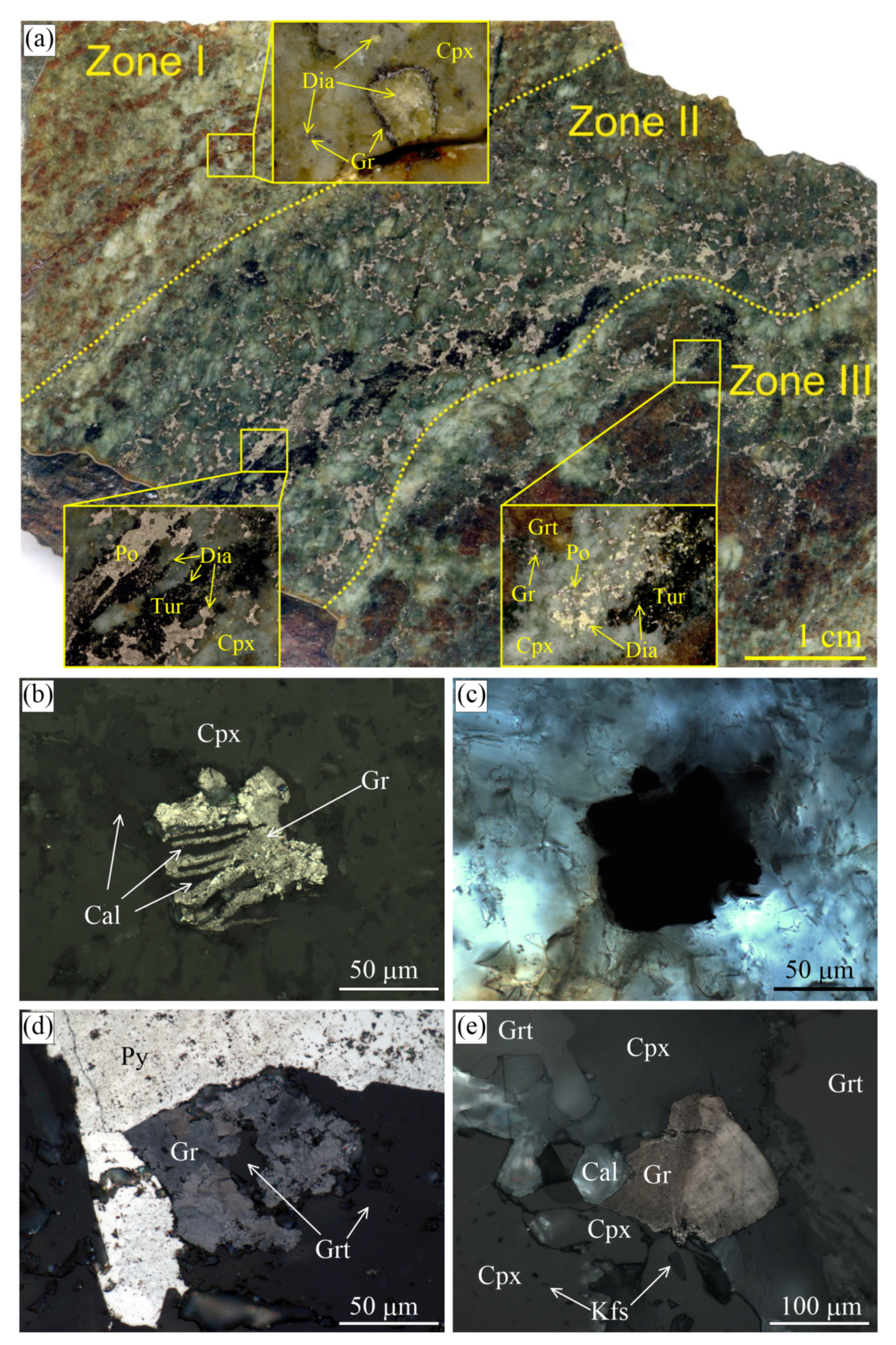

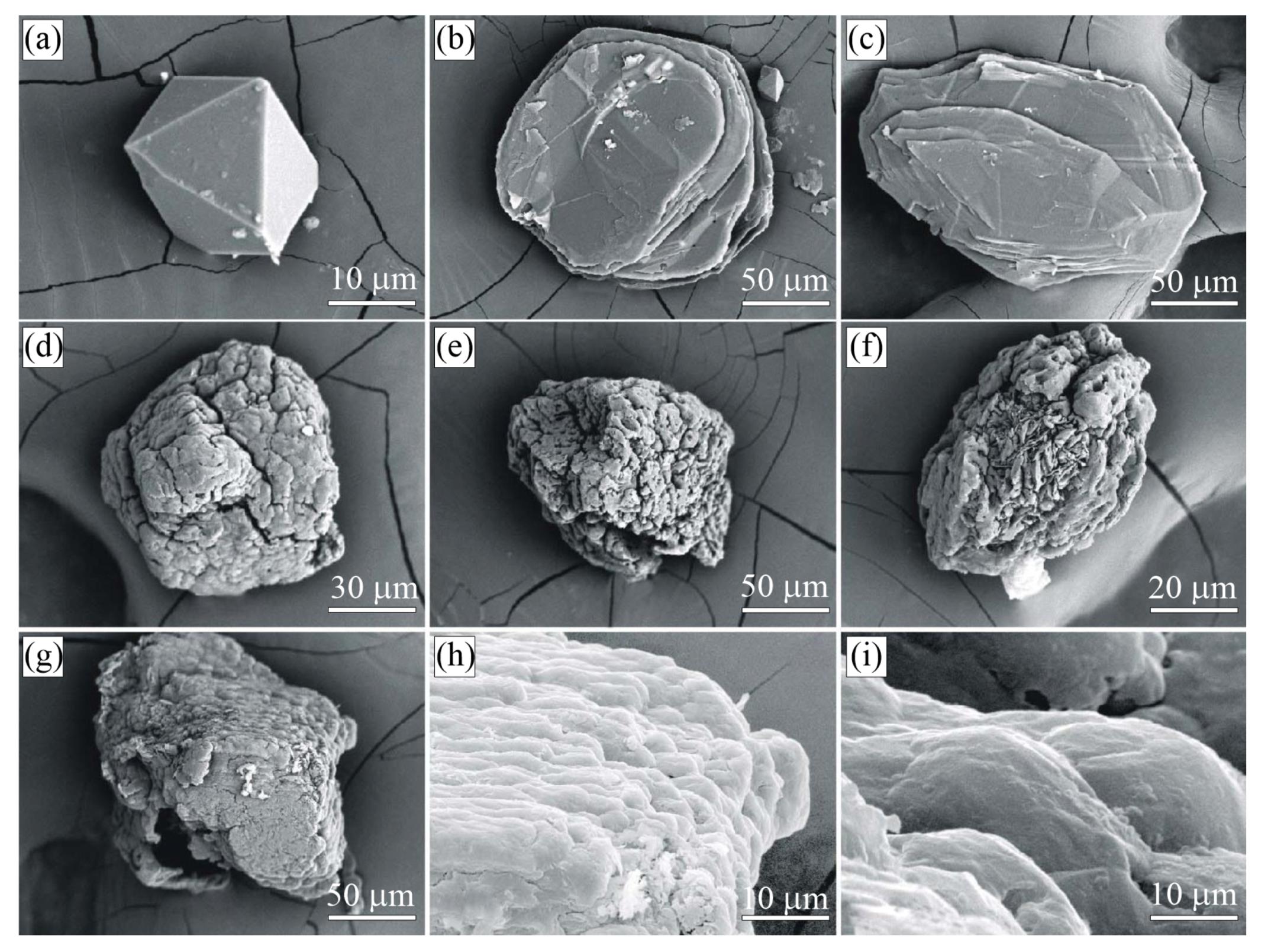
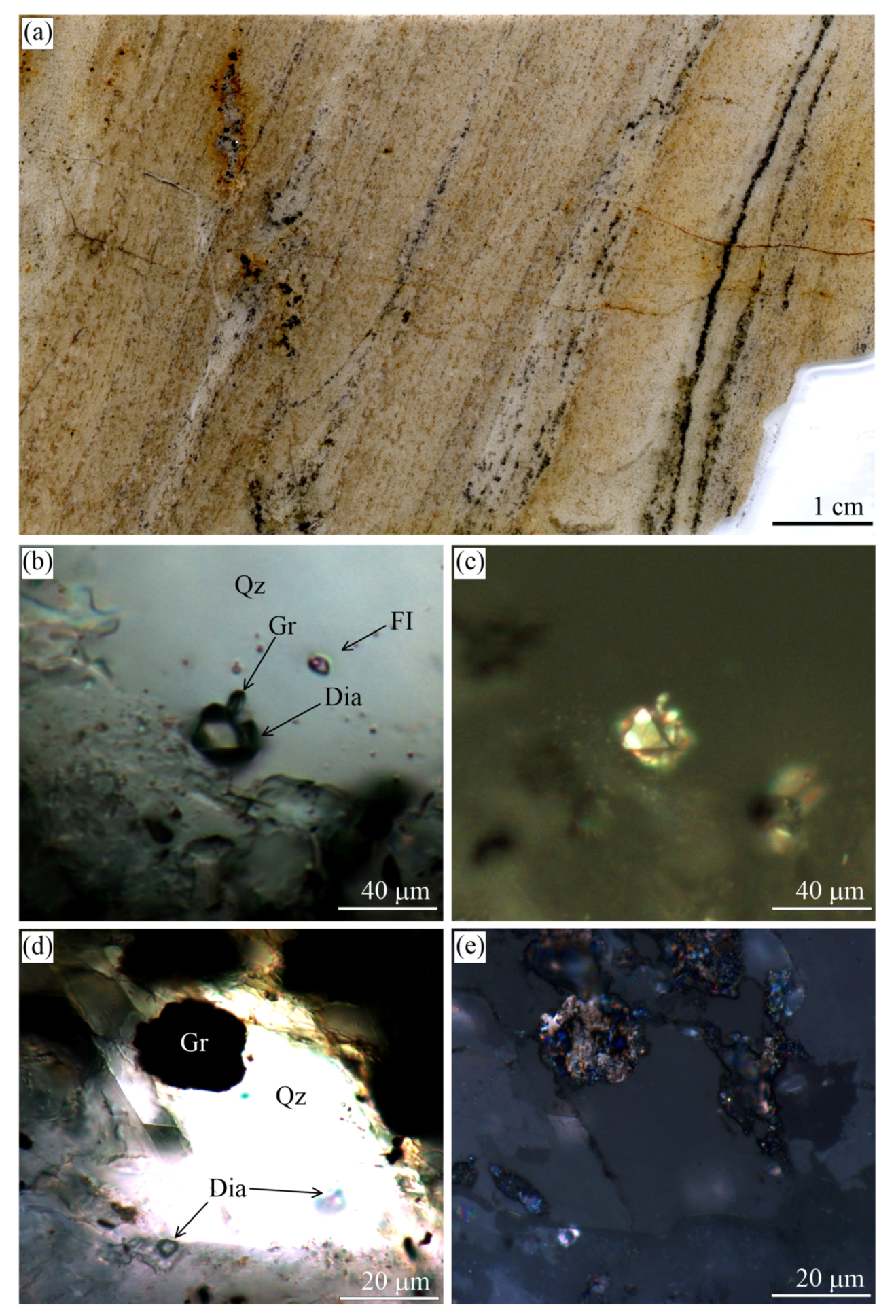
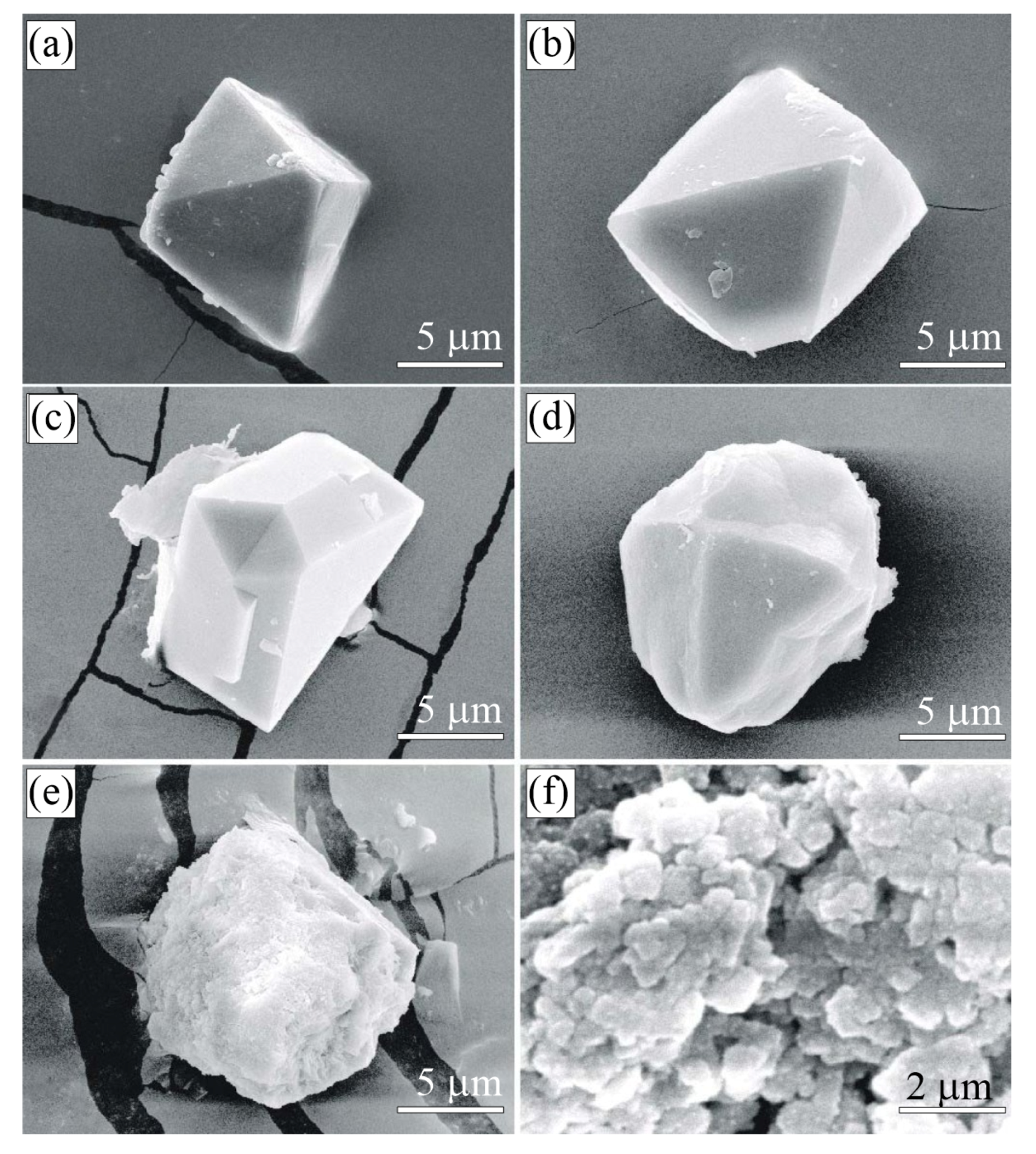
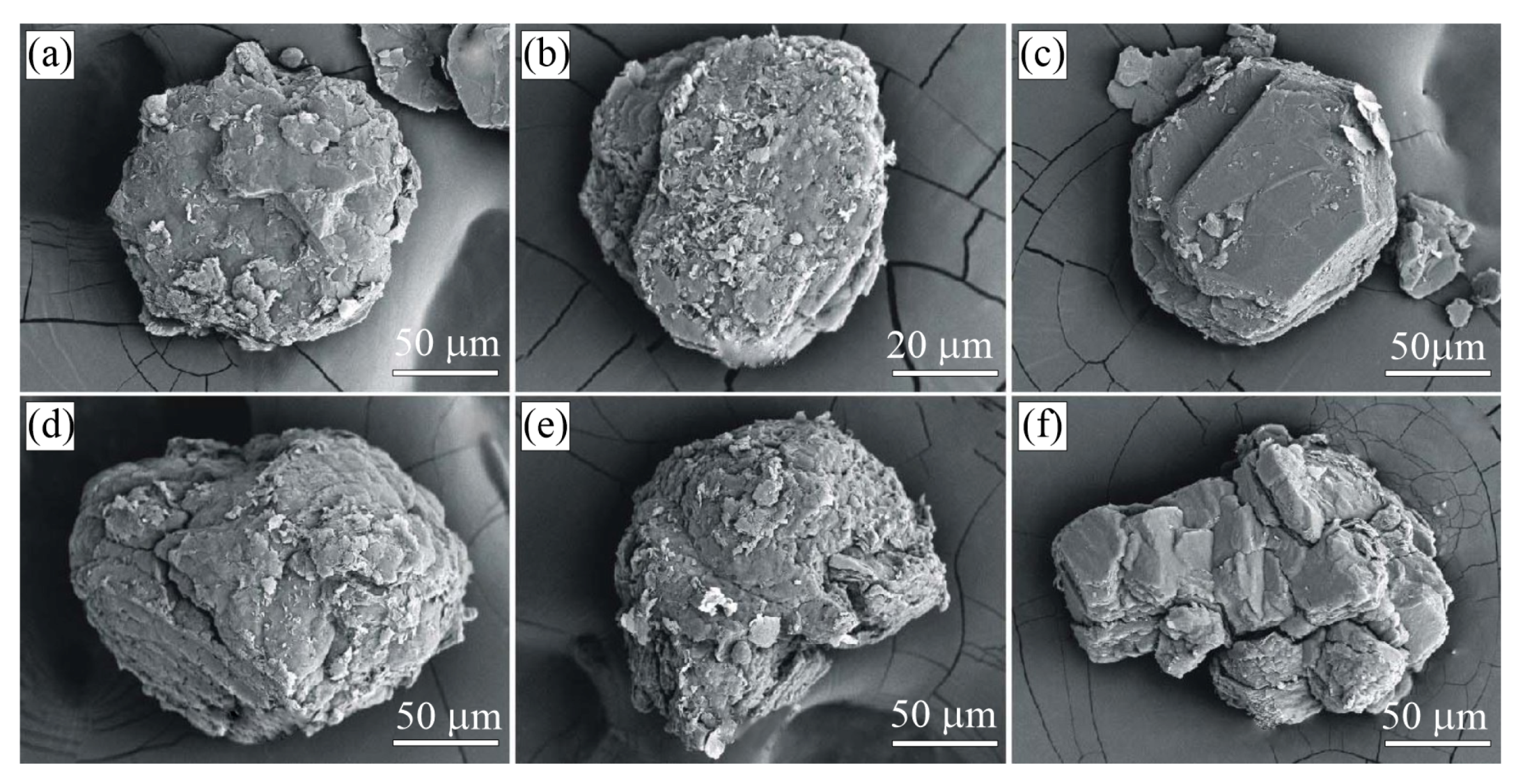
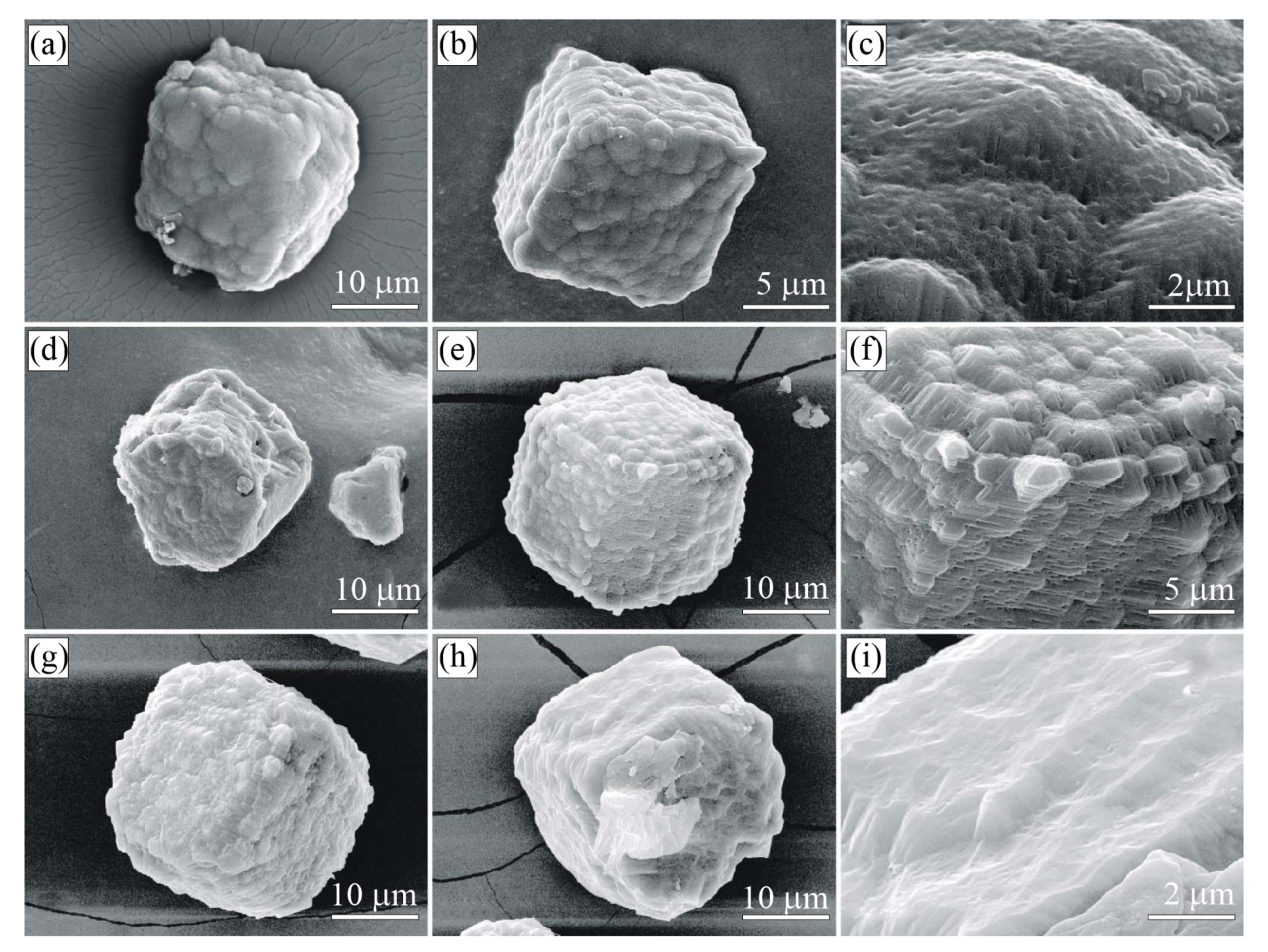
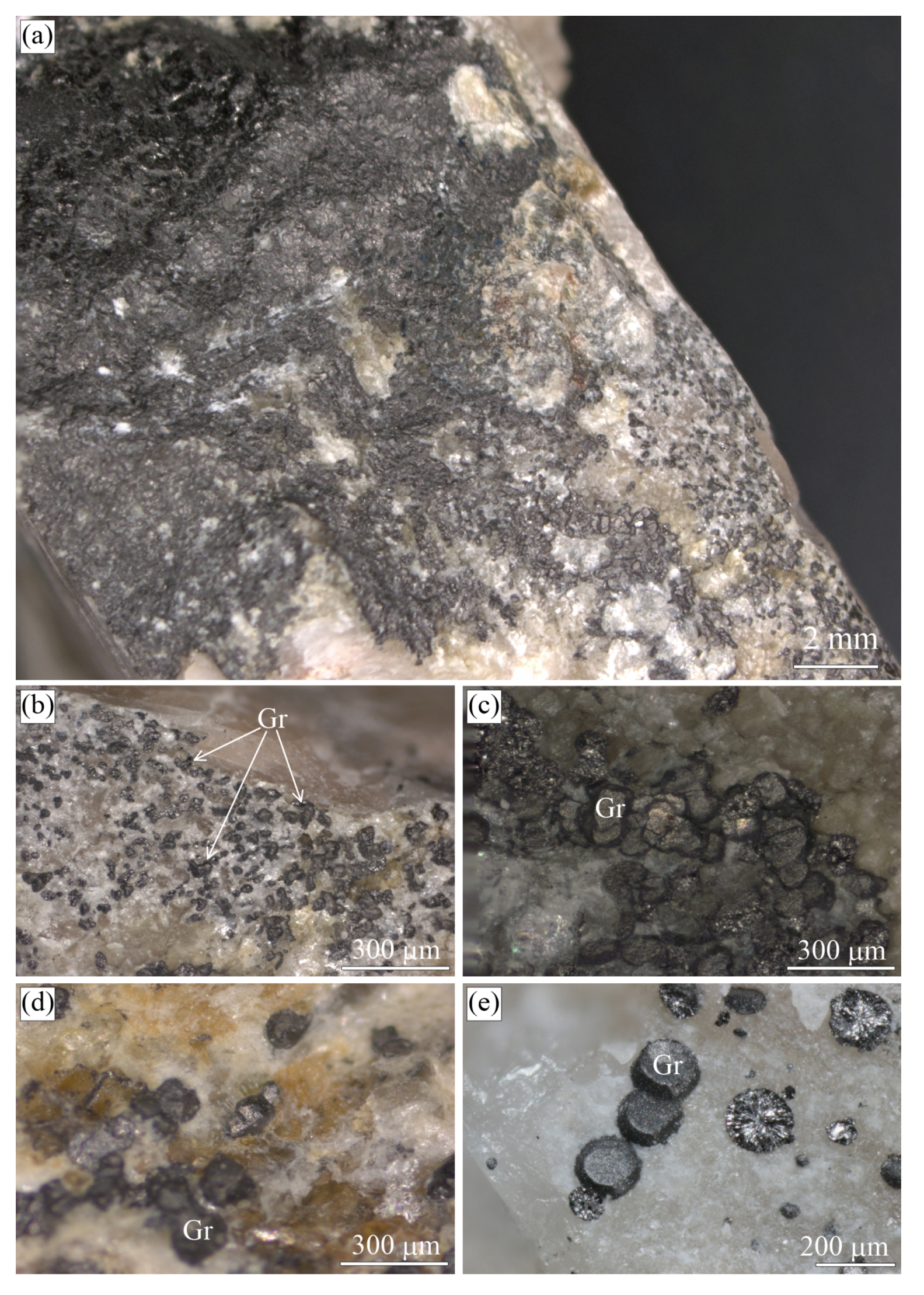
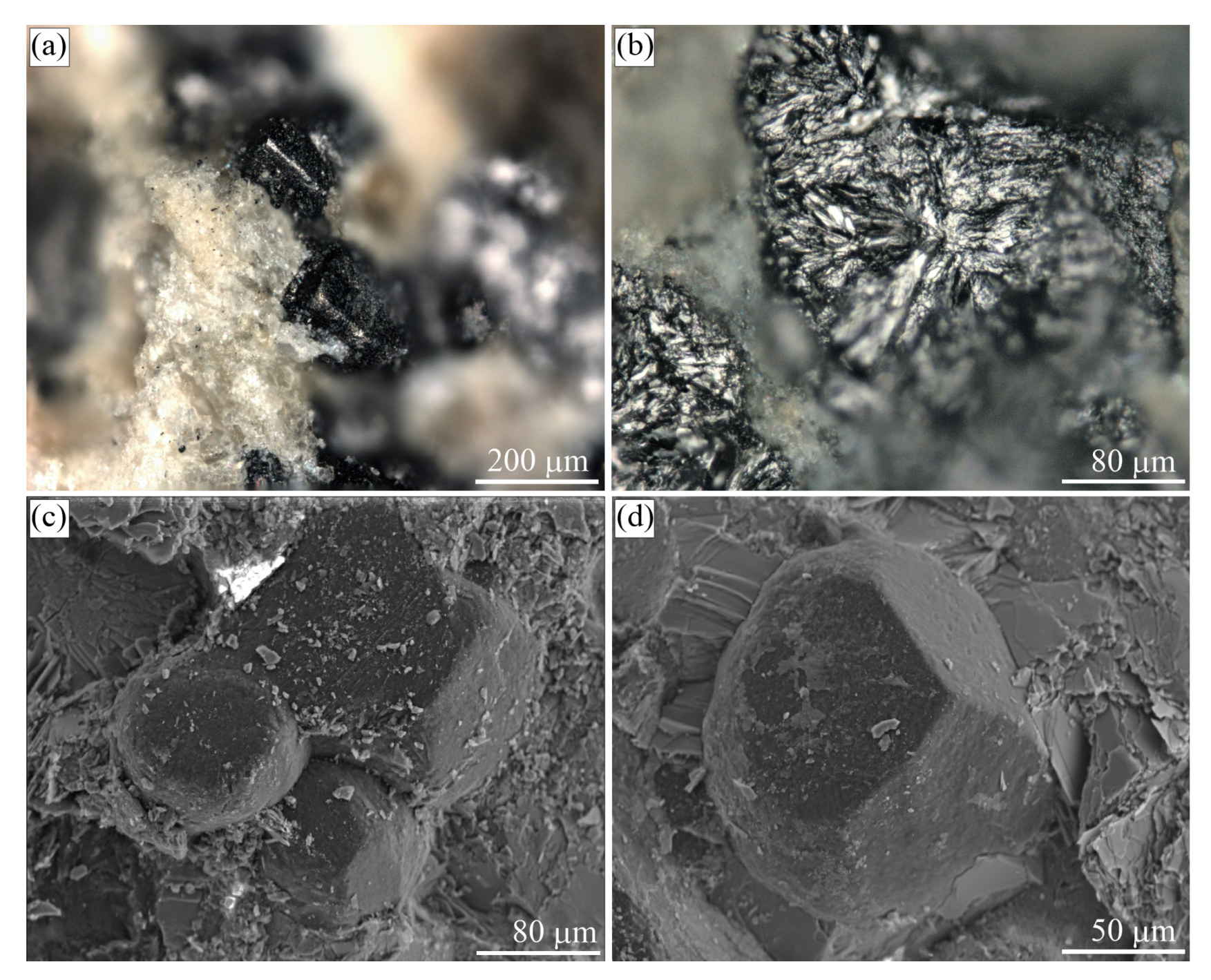
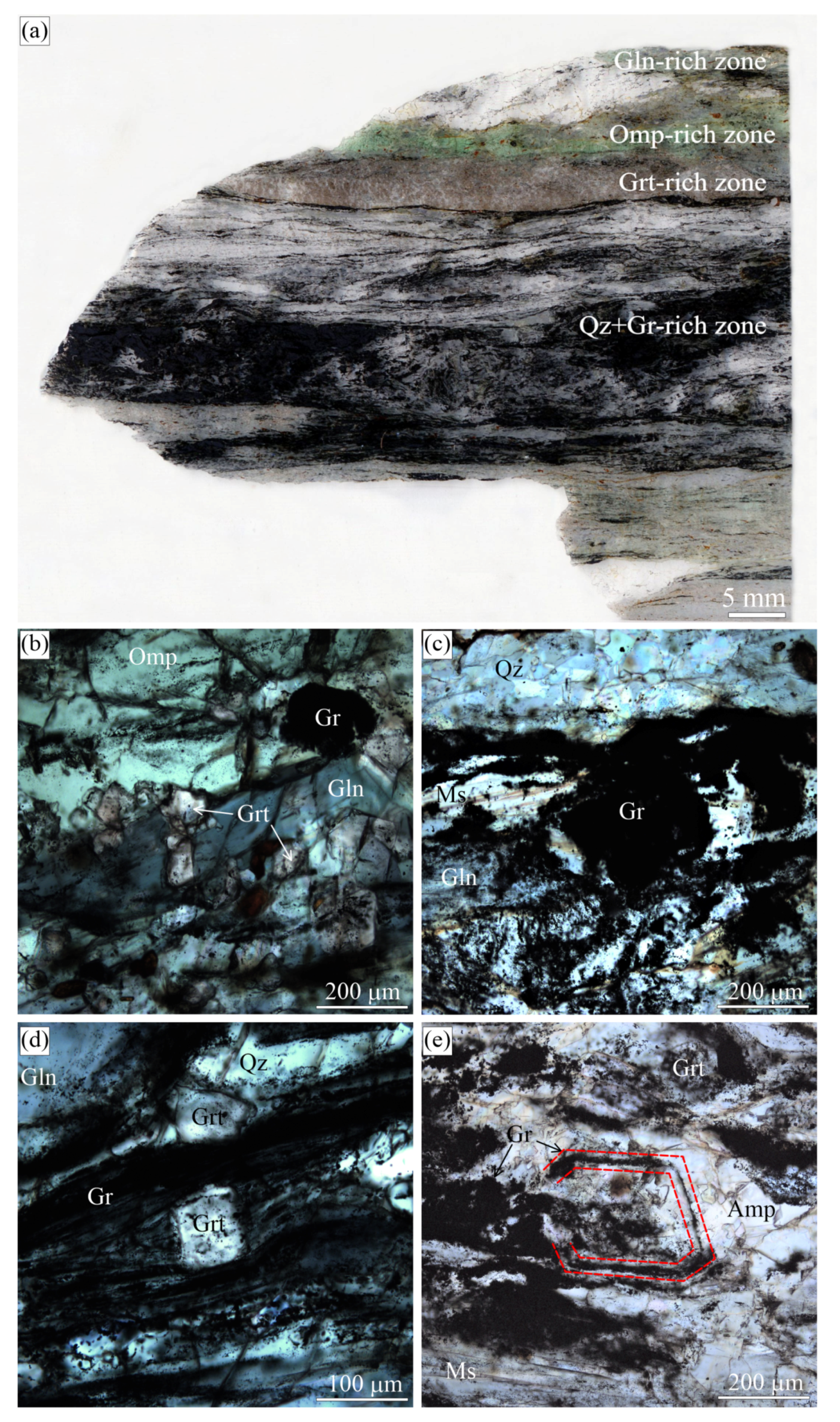
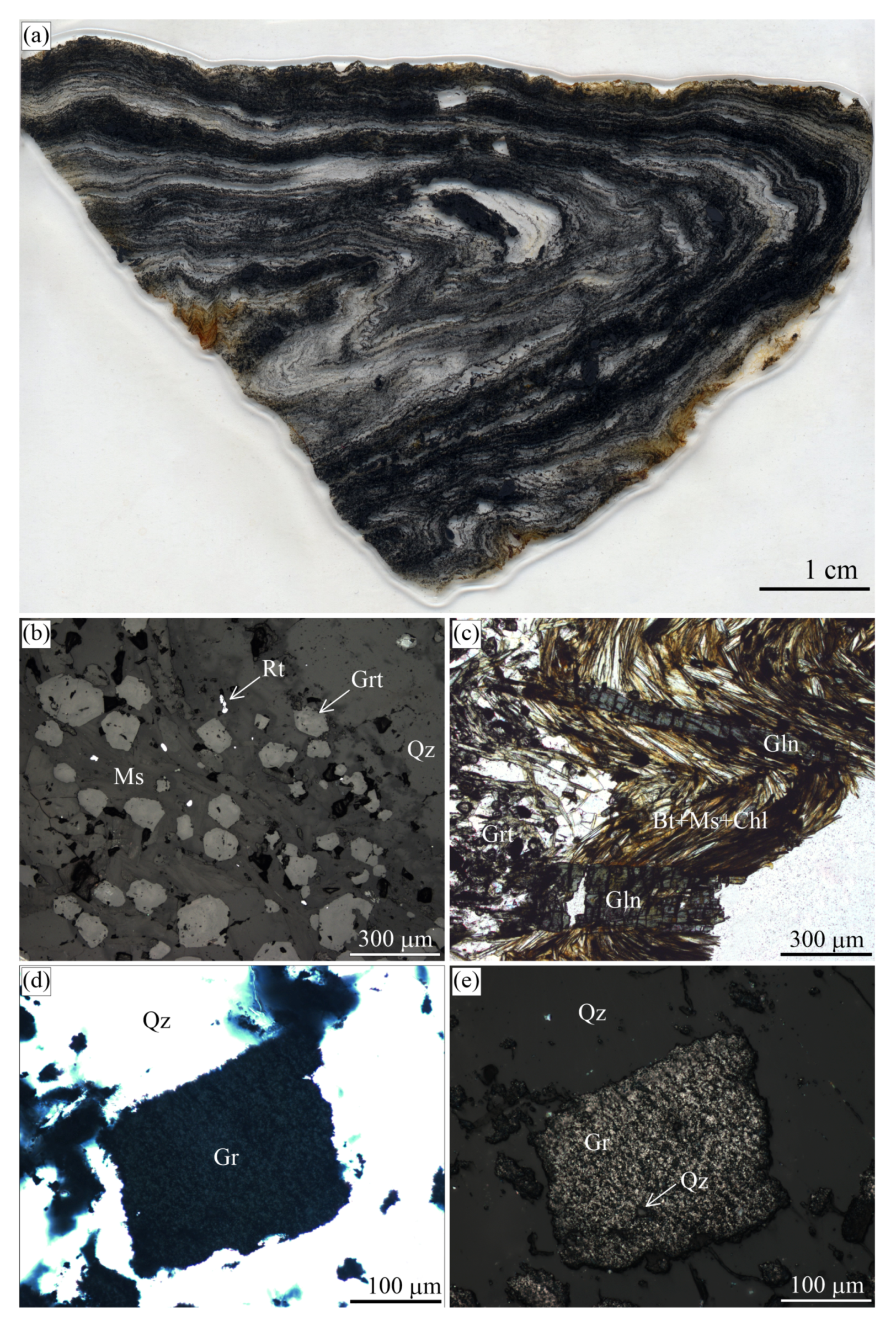
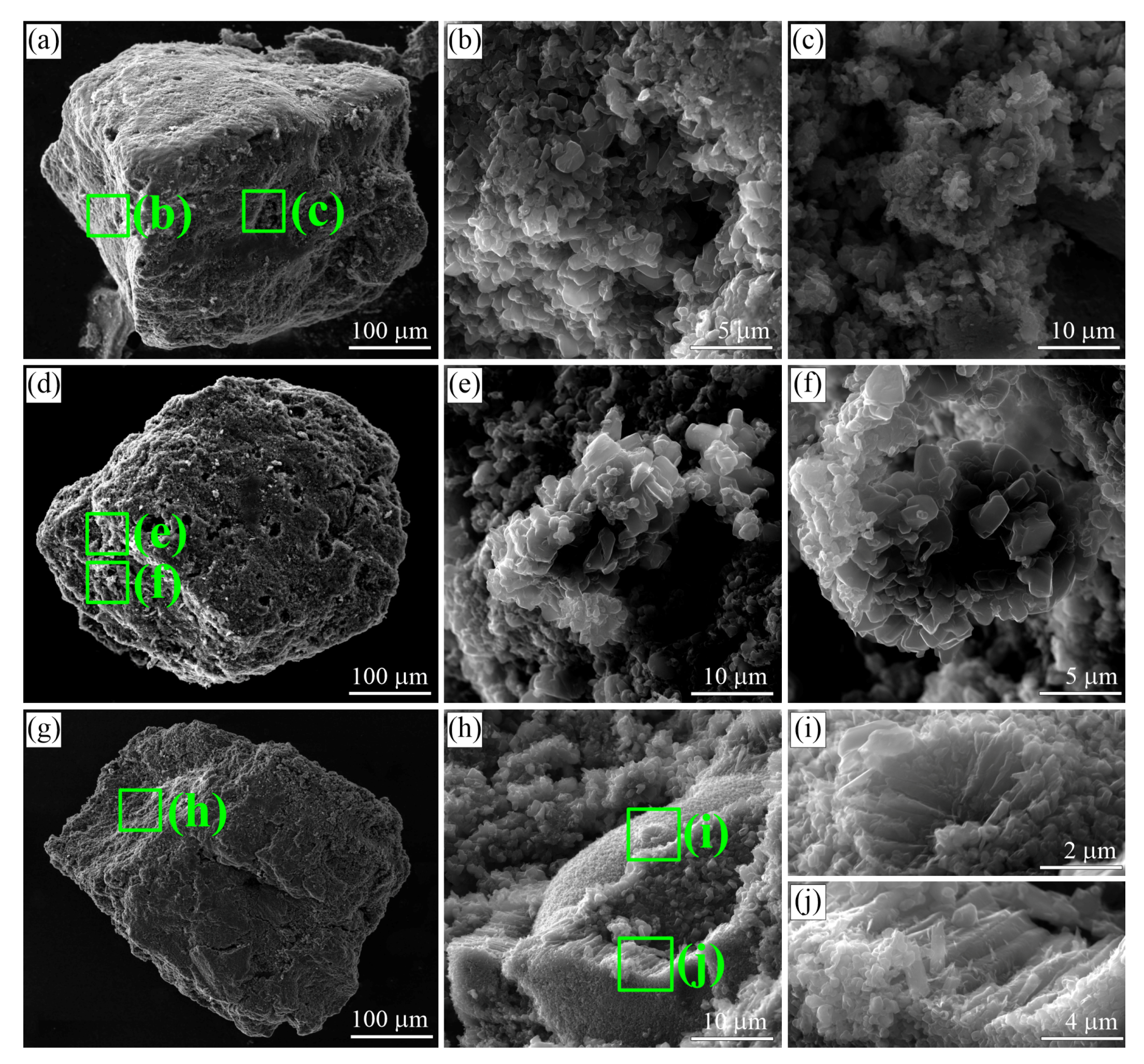
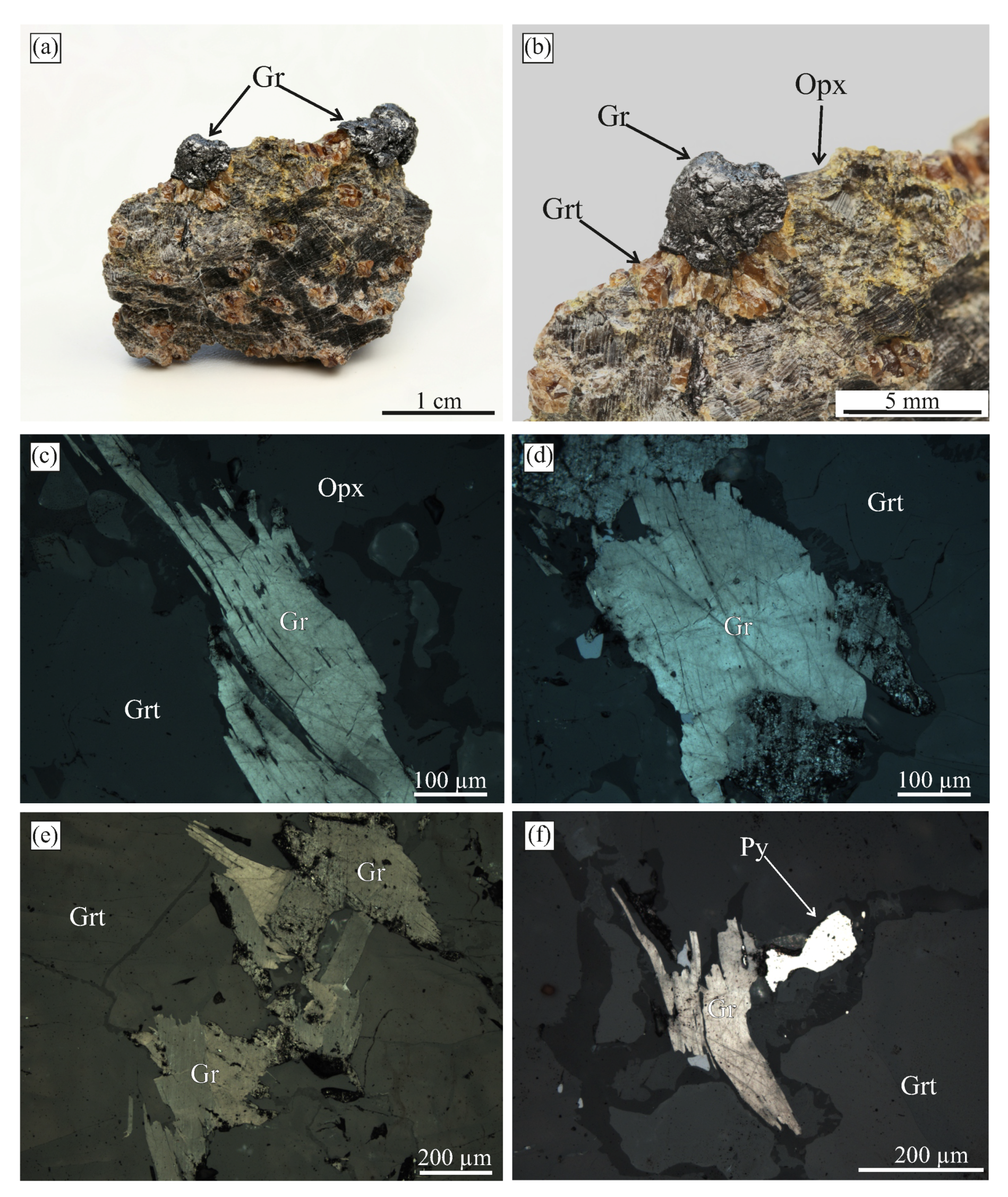
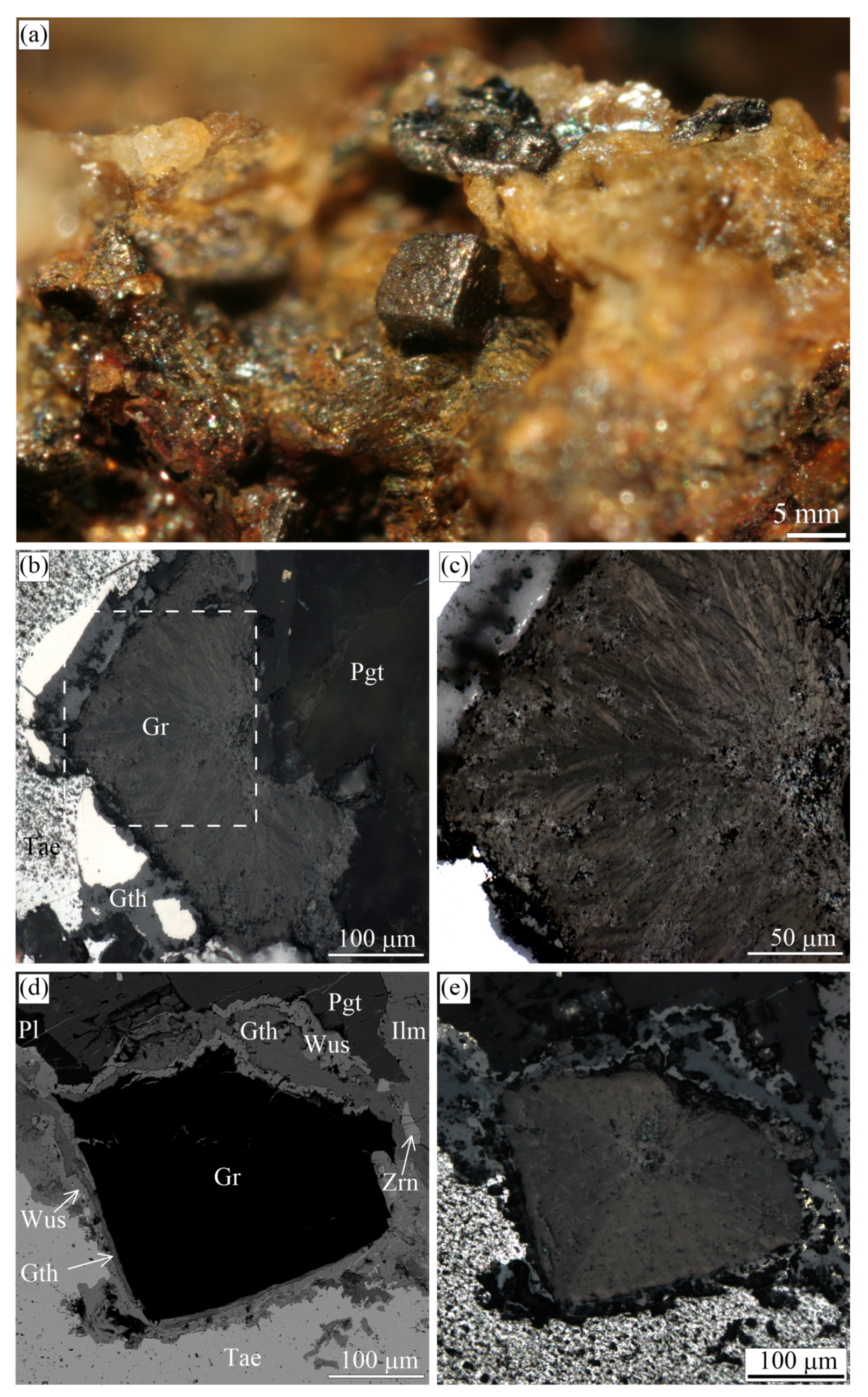

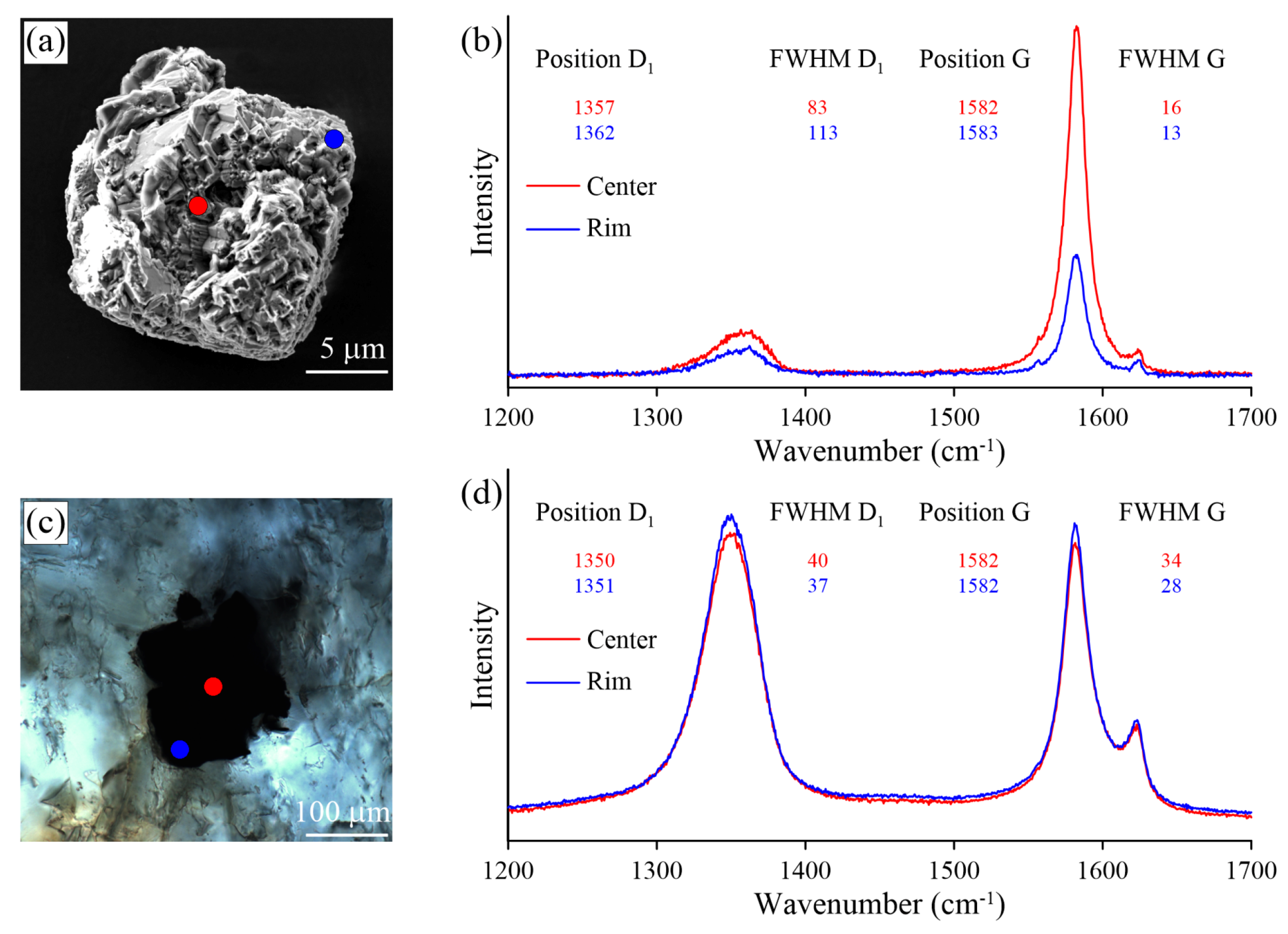
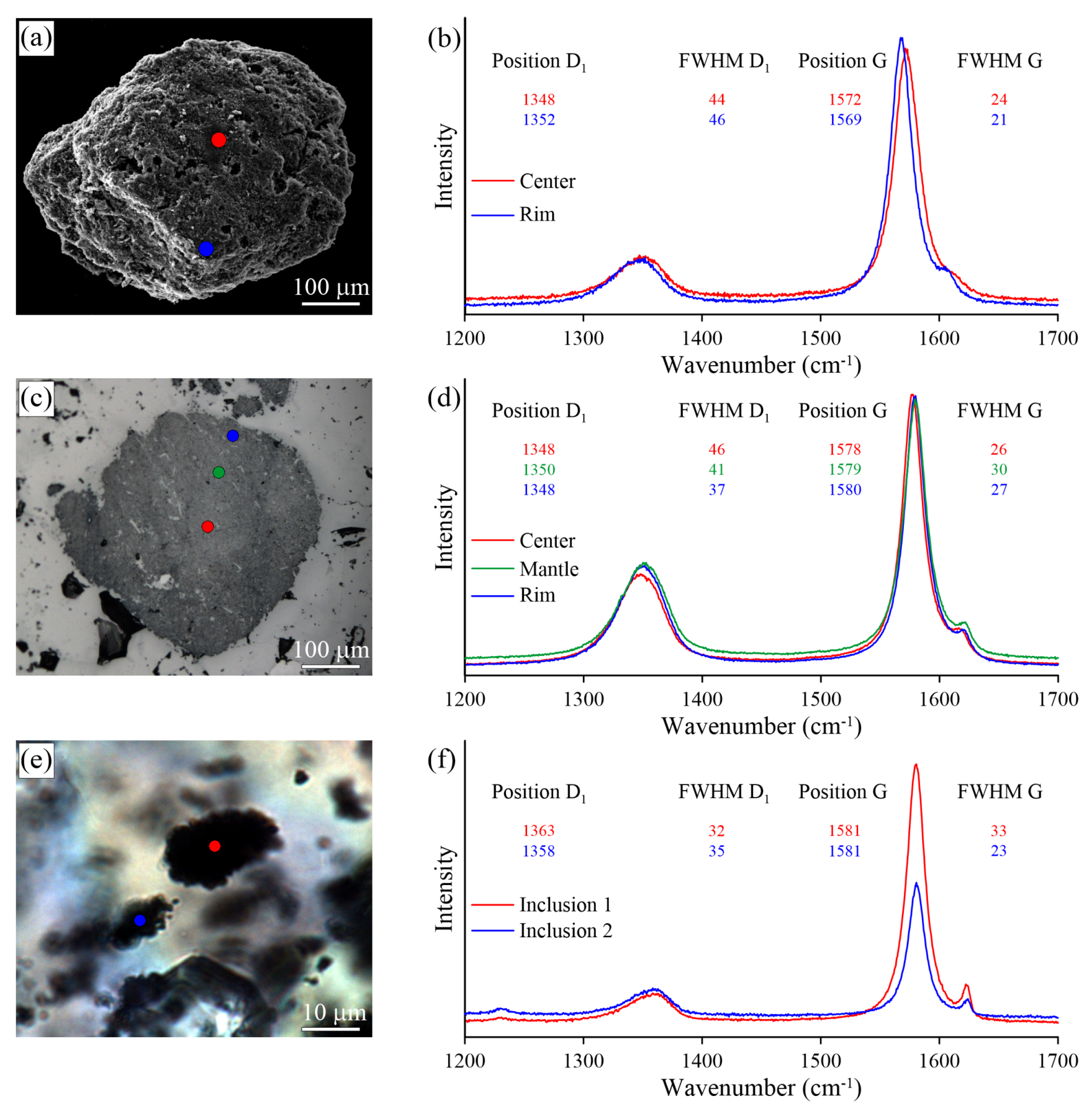
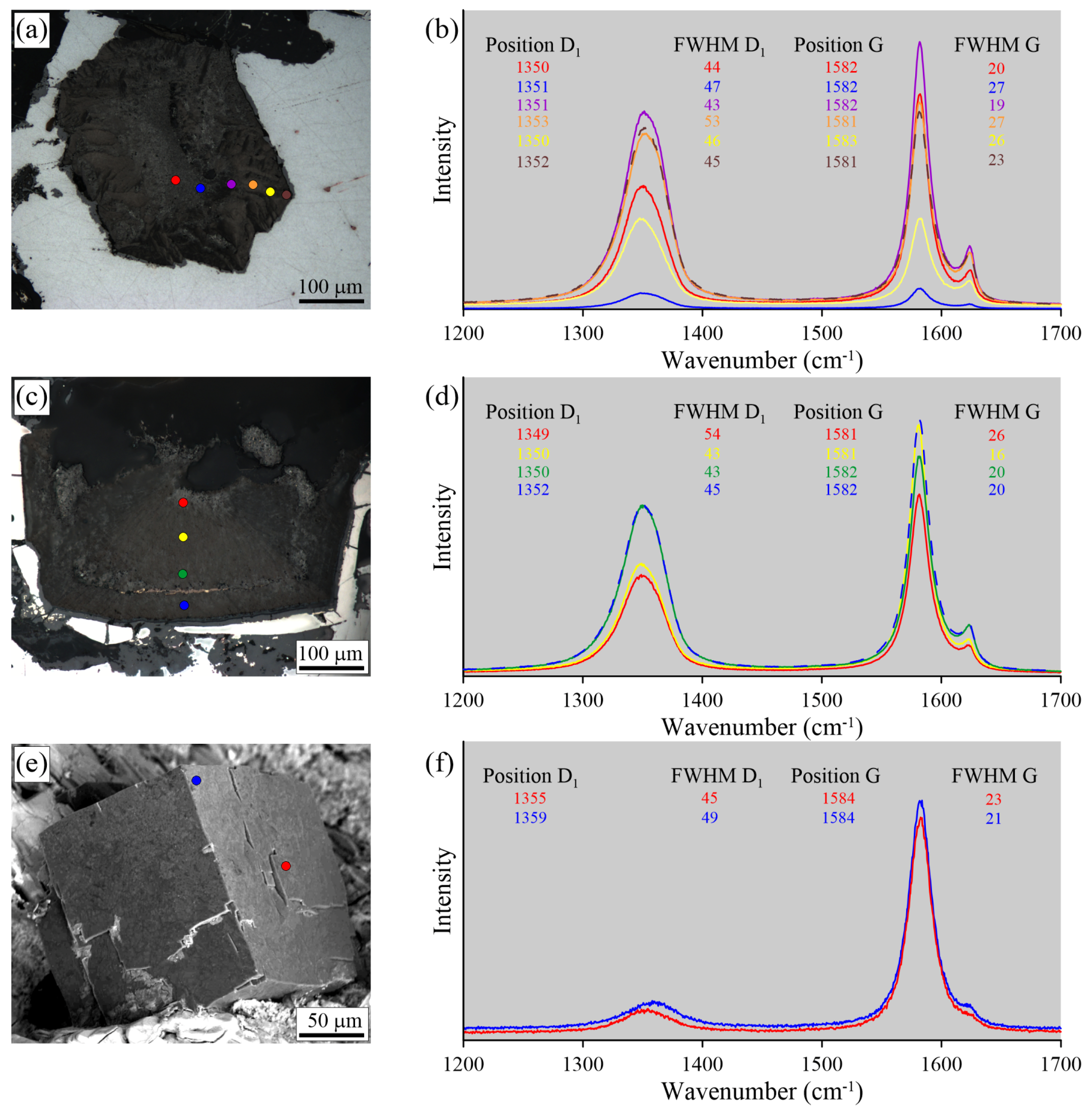
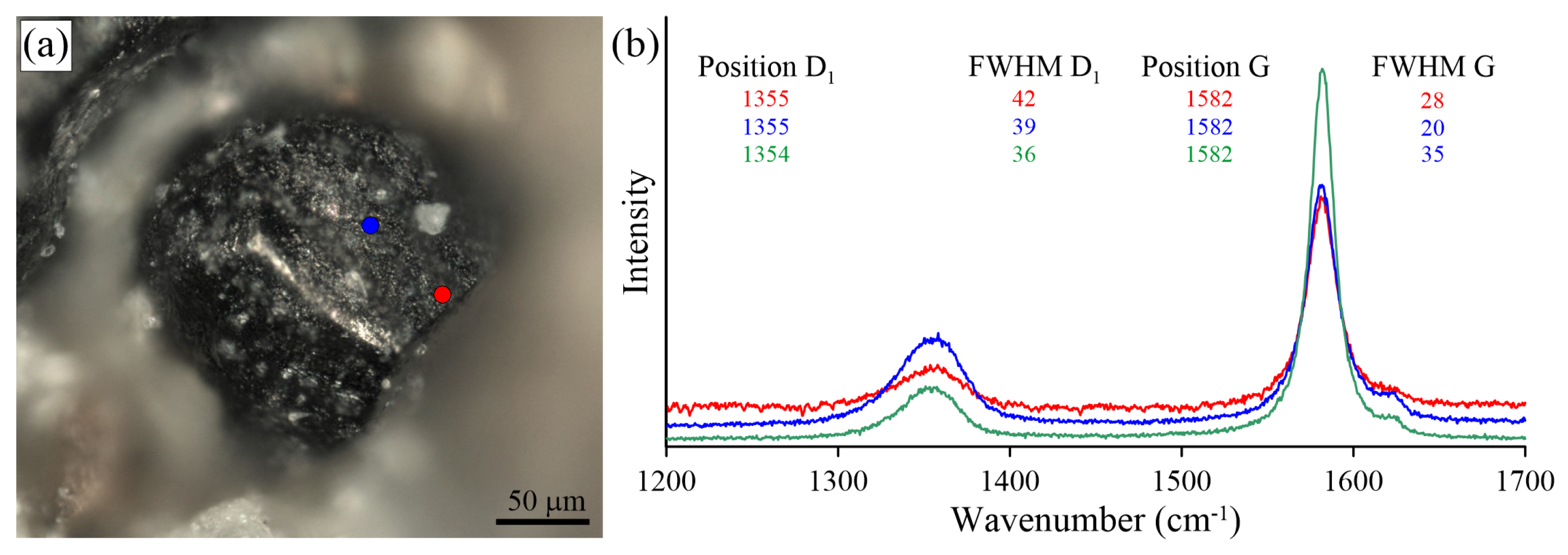
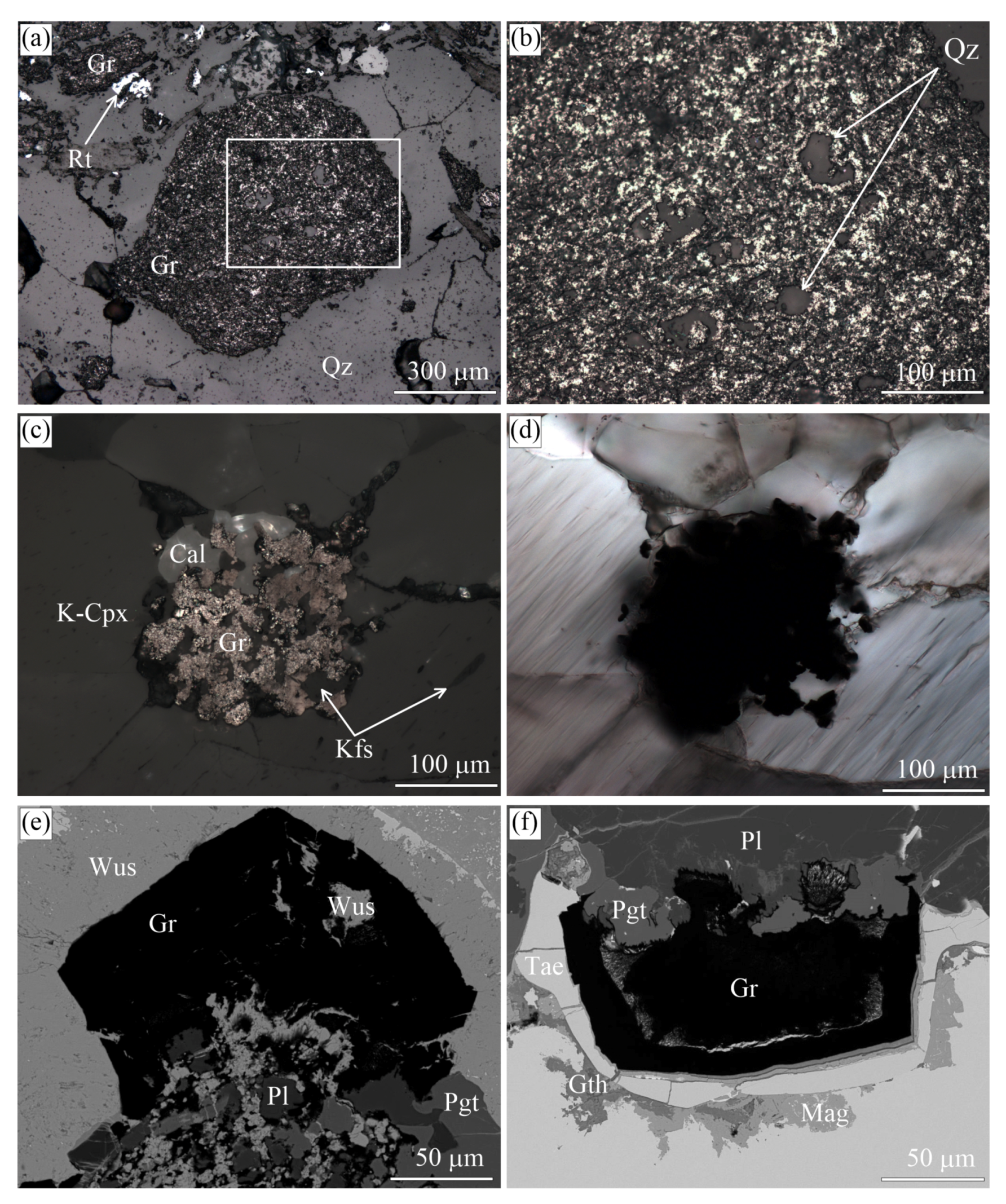
| Location | Mineral Assemblages | Gr Morphology | Gr Size | PT |
|---|---|---|---|---|
| Kokchetav massif (Kazakhstan) | Grt + K-Cpx ± Dol ± Mg–Cal ± Sul | c, s, f | up to 700 m | 1000–1100 C, 6–7 GPa [58] |
| Grt + Bt + Kfs + Qz ± Ky ± Tur ± Czo ± Sul | c, s, f | up to 500 m | 950–1000 C, 4–5 GPa [61] | |
| Estes Quarry, West Baldwin, Maine (USA) | Ab | c, s, f | up to 1 mm | unknown |
| Maksyutov complex (South Ural, Russia) | Qz + Phe + Omp + Gln ± Sul | c, s, f | up to 15 mm | 600 C, 1.5–1.7 GPa [62] |
| Beni Bousera (Morocco) | Opx + Grt ± Sul | i.a., f | up to 15 mm | 1300 C, >4 GPa [63] |
| Ozernaya (Norilsk, Russia) | Fe + Wus + Tae + Ilm + Pl + Pgt ± Sul | c | up 300 m | 750–1200 C [25] |
| Sample Locality | Peak Position | FWHM | R1 | R2 | T(C, C) | ||
|---|---|---|---|---|---|---|---|
| D1 | G | D1 | G | ||||
| Estes Quarry | 1355 | 1582 | 39 | 20 | 0.36 | 0.38 | 470 |
| Kokchetav massif | 1357 | 1582 | 83 | 16 | 0.16 | 0.38 | 470 |
| Maksyutov complex | 1360 | 1580 | 43 | 28 | 0.15 | 0.2 | 550 |
| Ozernaya | 1355 | 1584 | 45 | 23 | 0.06 | 0.03 | 625 |
© 2019 by the authors. Licensee MDPI, Basel, Switzerland. This article is an open access article distributed under the terms and conditions of the Creative Commons Attribution (CC BY) license (http://creativecommons.org/licenses/by/4.0/).
Share and Cite
Korsakov, A.V.; Rezvukhina, O.V.; Jaszczak, J.A.; Rezvukhin, D.I.; Mikhailenko, D.S. Natural Graphite Cuboids. Minerals 2019, 9, 110. https://doi.org/10.3390/min9020110
Korsakov AV, Rezvukhina OV, Jaszczak JA, Rezvukhin DI, Mikhailenko DS. Natural Graphite Cuboids. Minerals. 2019; 9(2):110. https://doi.org/10.3390/min9020110
Chicago/Turabian StyleKorsakov, Andrey V., Olga V. Rezvukhina, John A. Jaszczak, Dmitriy I. Rezvukhin, and Denis S. Mikhailenko. 2019. "Natural Graphite Cuboids" Minerals 9, no. 2: 110. https://doi.org/10.3390/min9020110
APA StyleKorsakov, A. V., Rezvukhina, O. V., Jaszczak, J. A., Rezvukhin, D. I., & Mikhailenko, D. S. (2019). Natural Graphite Cuboids. Minerals, 9(2), 110. https://doi.org/10.3390/min9020110







